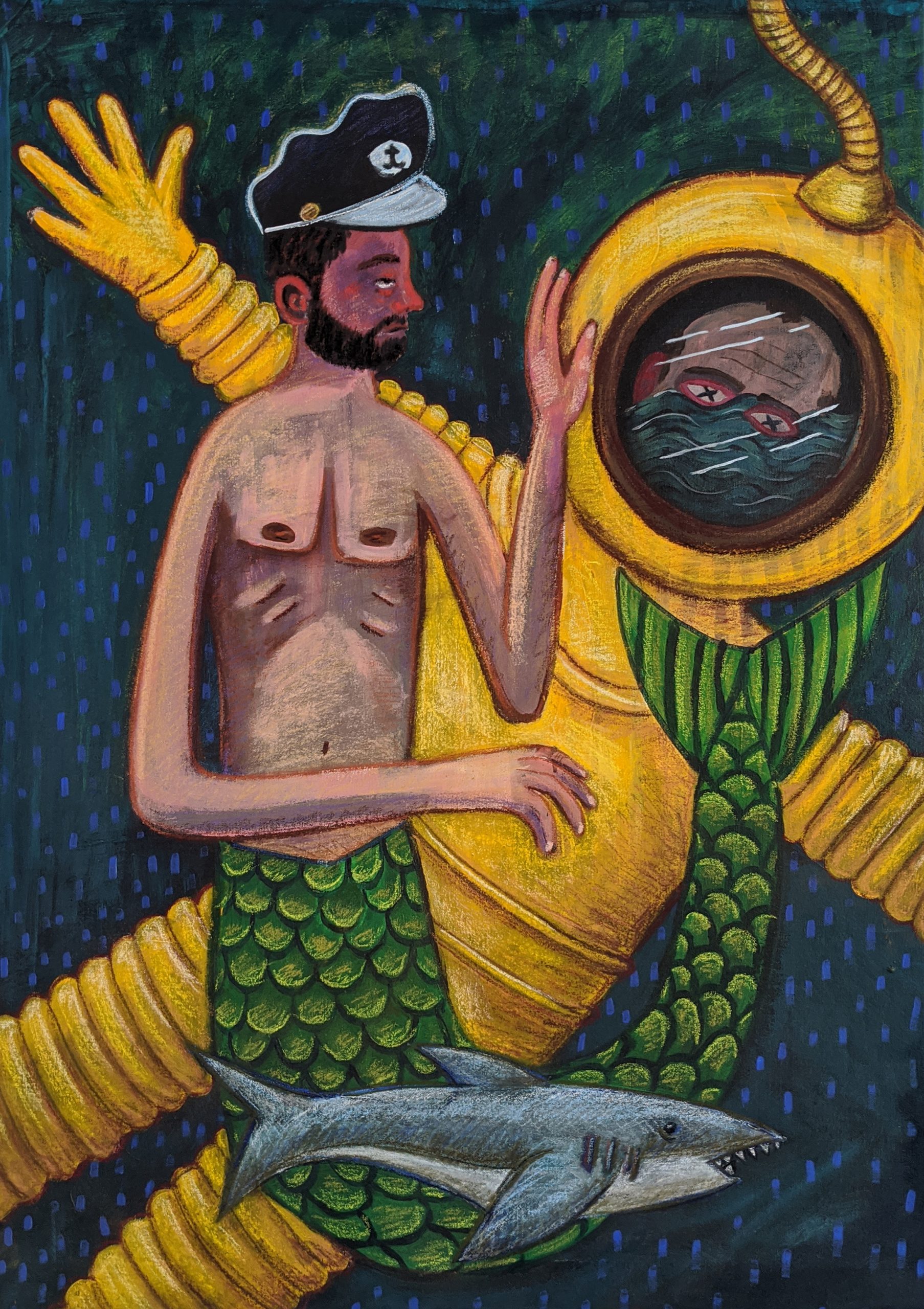
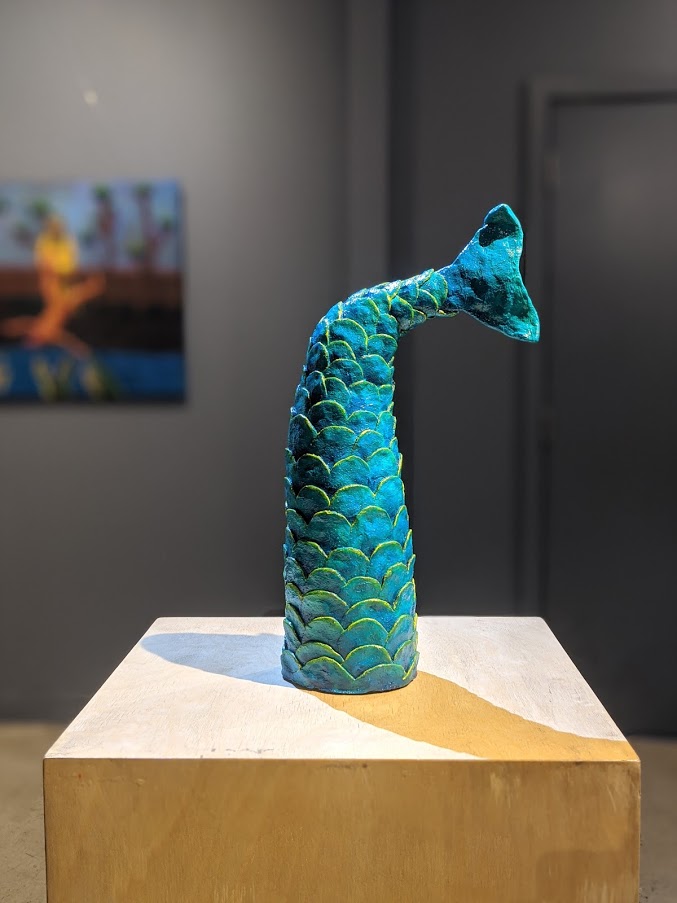
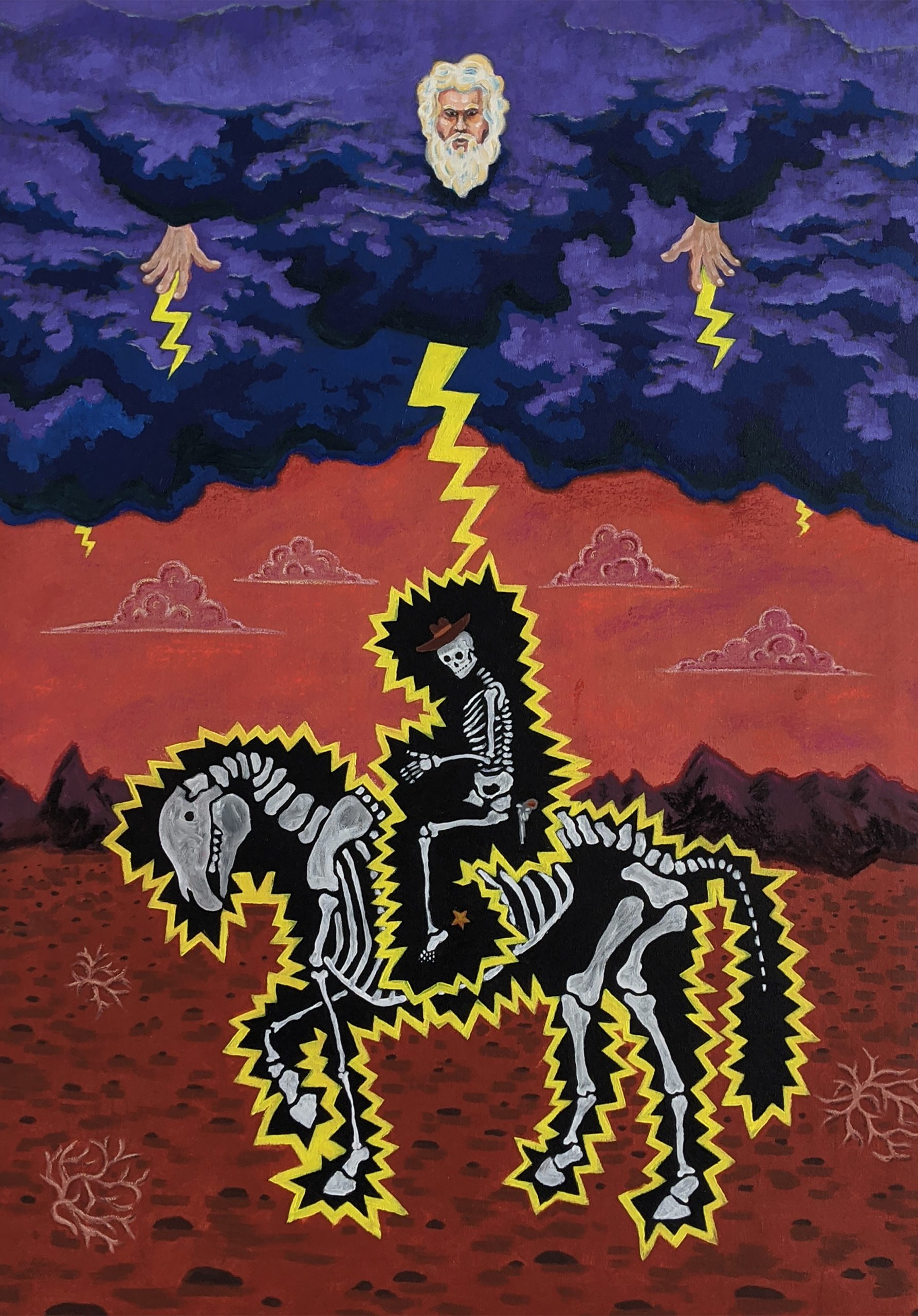
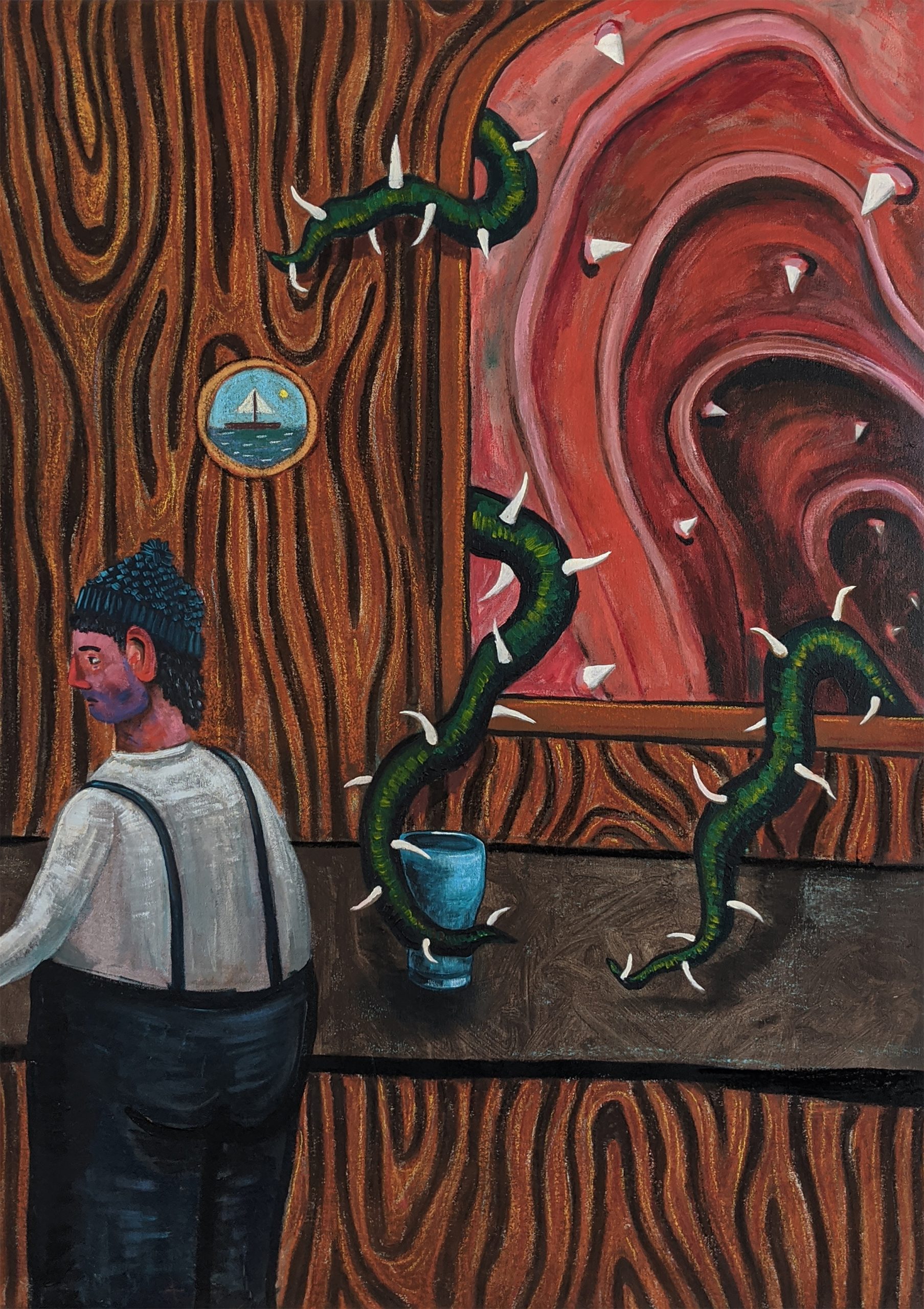
a collaboration with Alex Mullen.
Sea Shanties explores the artists surreal interpretations of their global adventures through their somewhat foggy memories. Their careers have seen them live, study and exhibit in many corners of the globe – from New York City to Kashmir, and all around Europe. In this exhibition they are drawing their memories, collaborating on paintings and recreating their iconic and sentimental objects as ceramics. Sea Shanties is a dream-like retelling of stories that maybe actually happened.
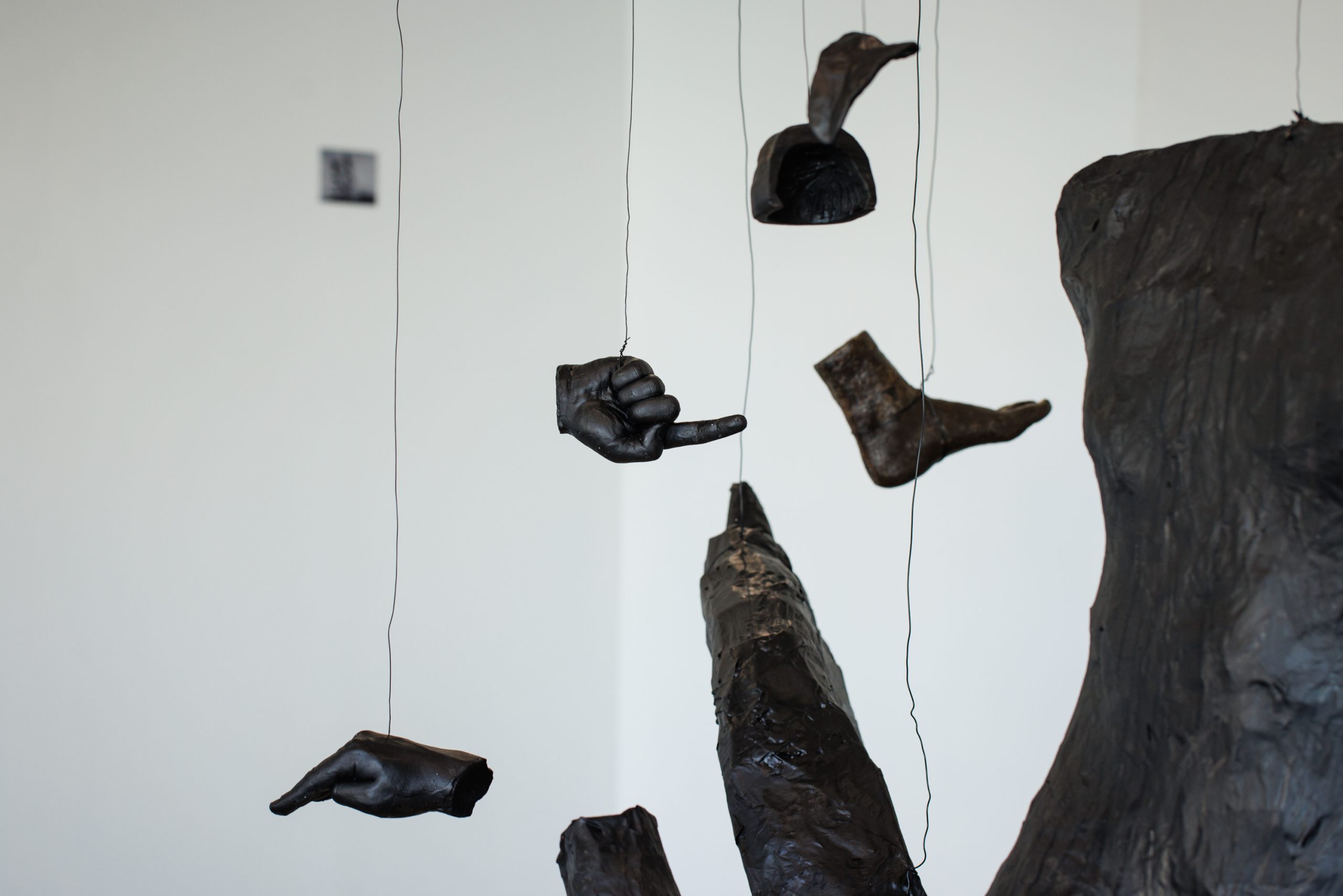
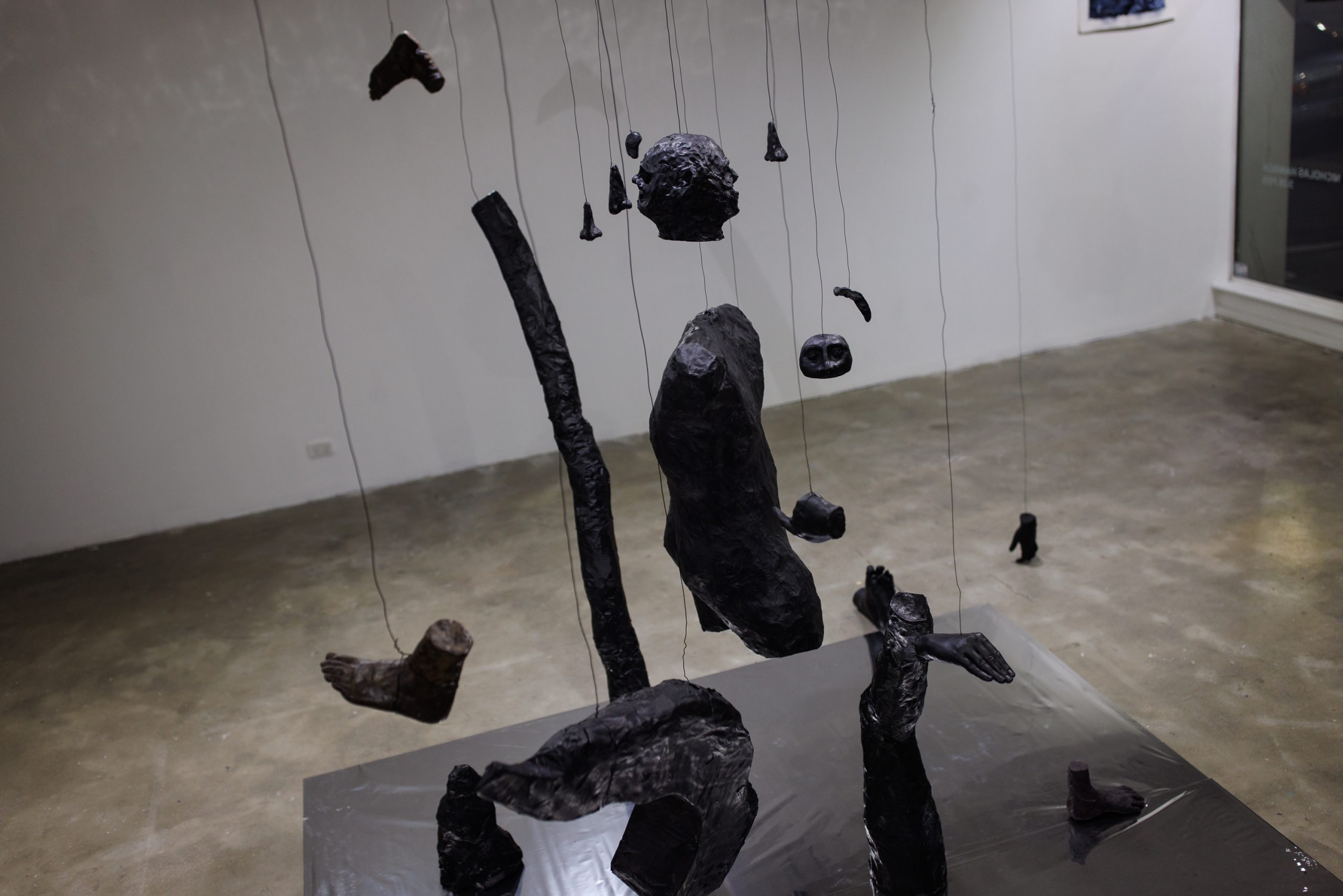

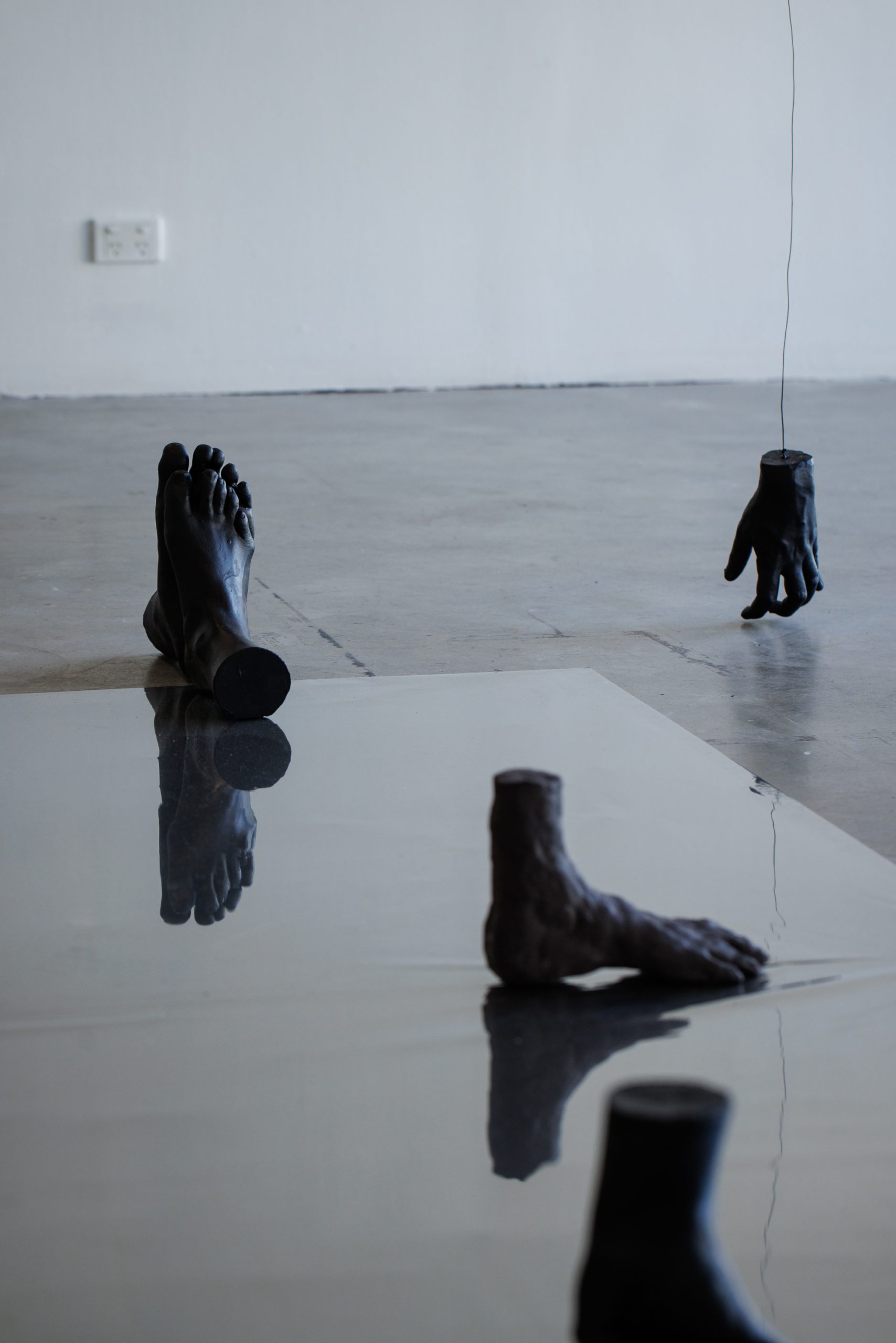
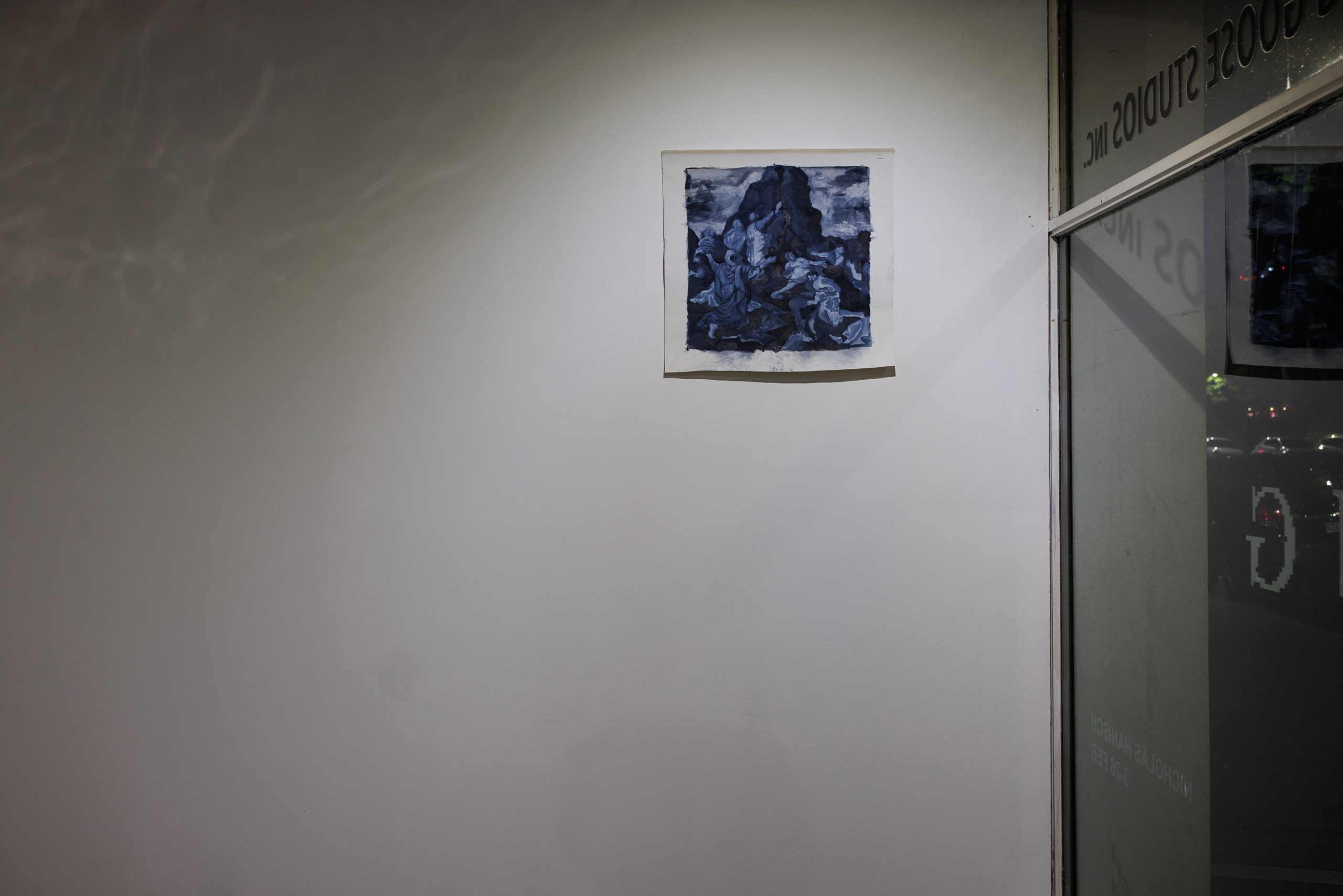
A solo exhibition at Floating Goose Studios.
This exhibition is speculation. It more or less happened this way. I’m interested in this existential narrative of an ancient primordial puddle. That every little quirk and nuance on this planet started way-back-when as an enormous puddle of magma, bubbling away, refining itself over millennia. Divergent tentacles of complexity twist and evolve through time, and any attempt to comprehend the threads of this infinite tapestry collapses into confuddled madness.
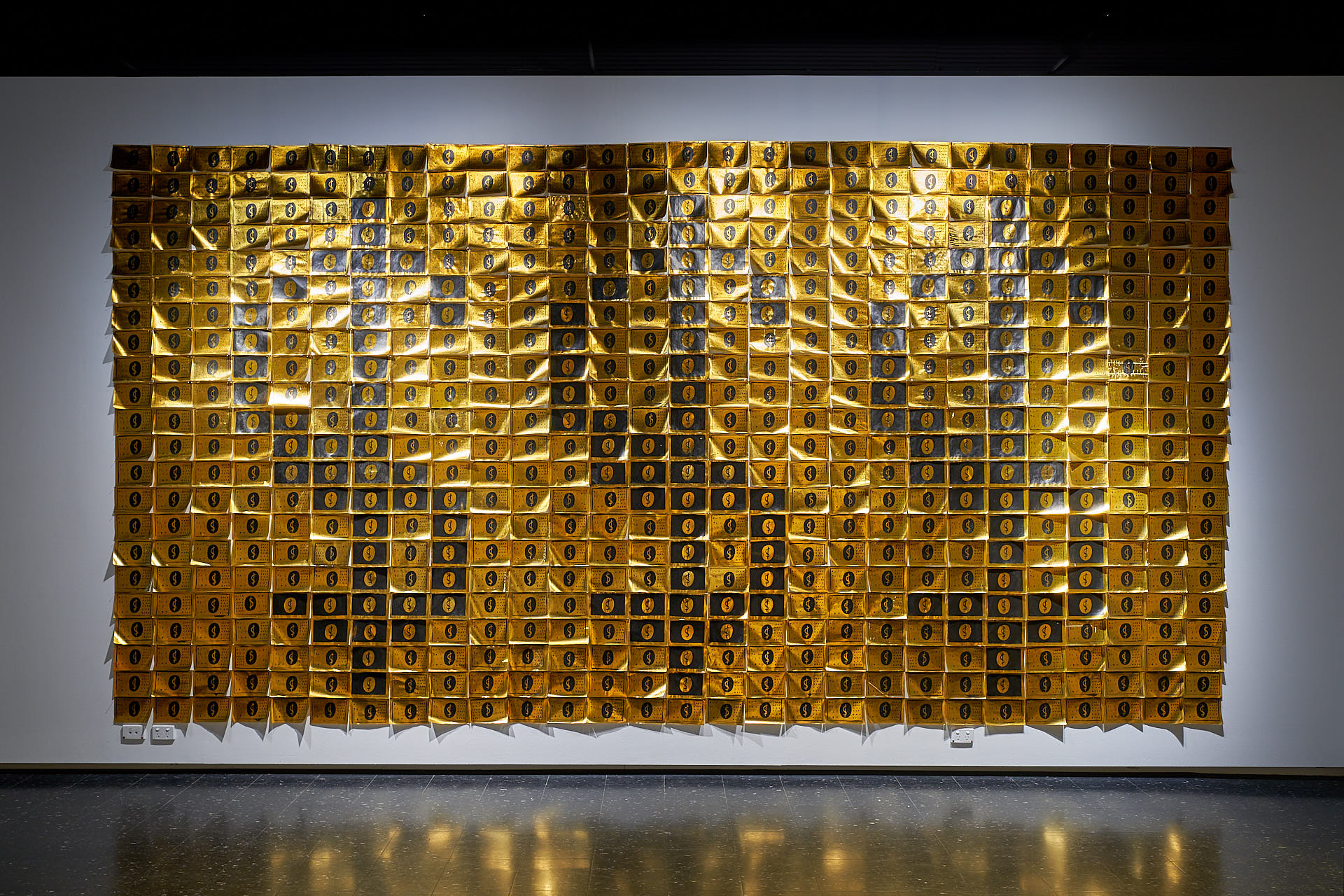
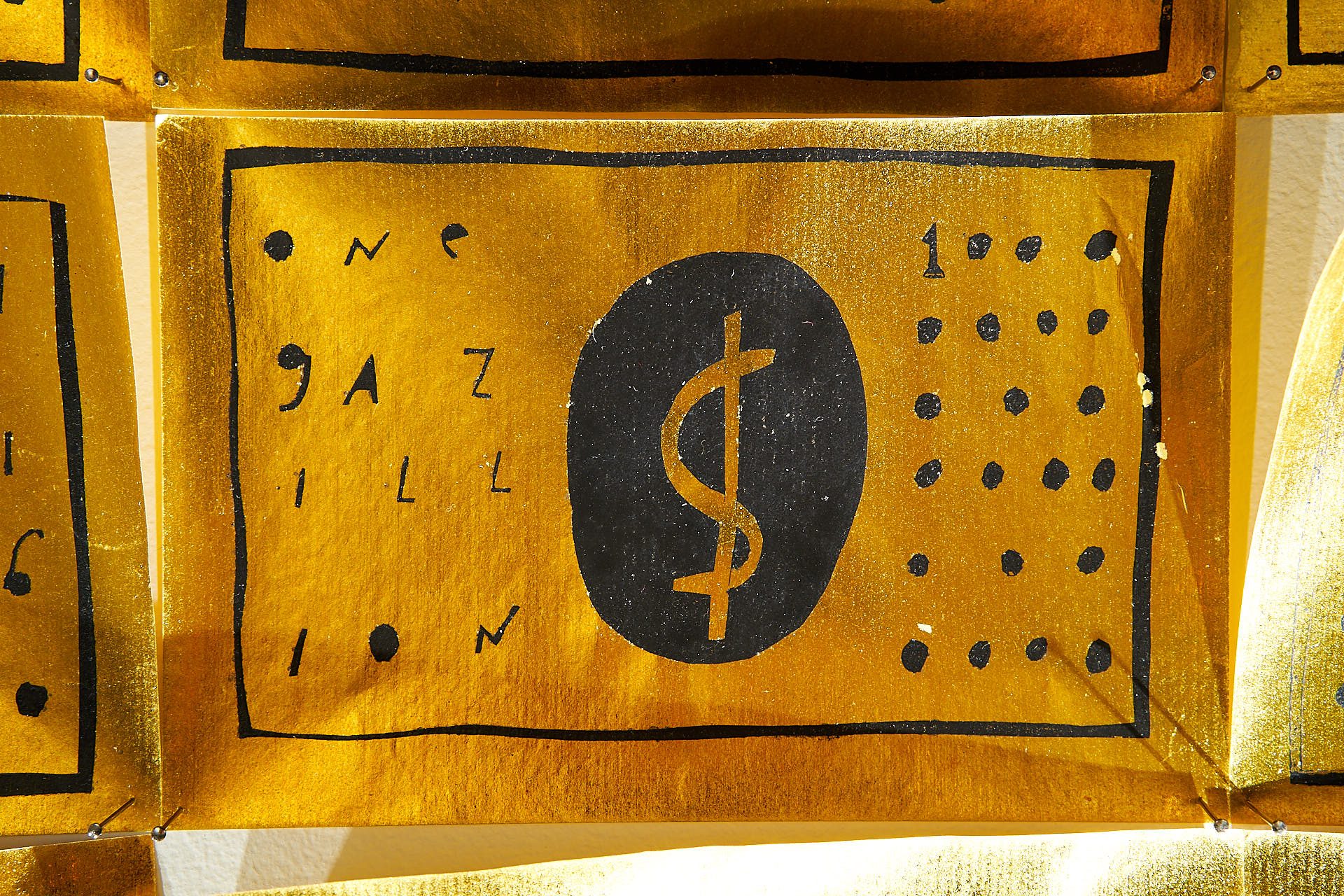
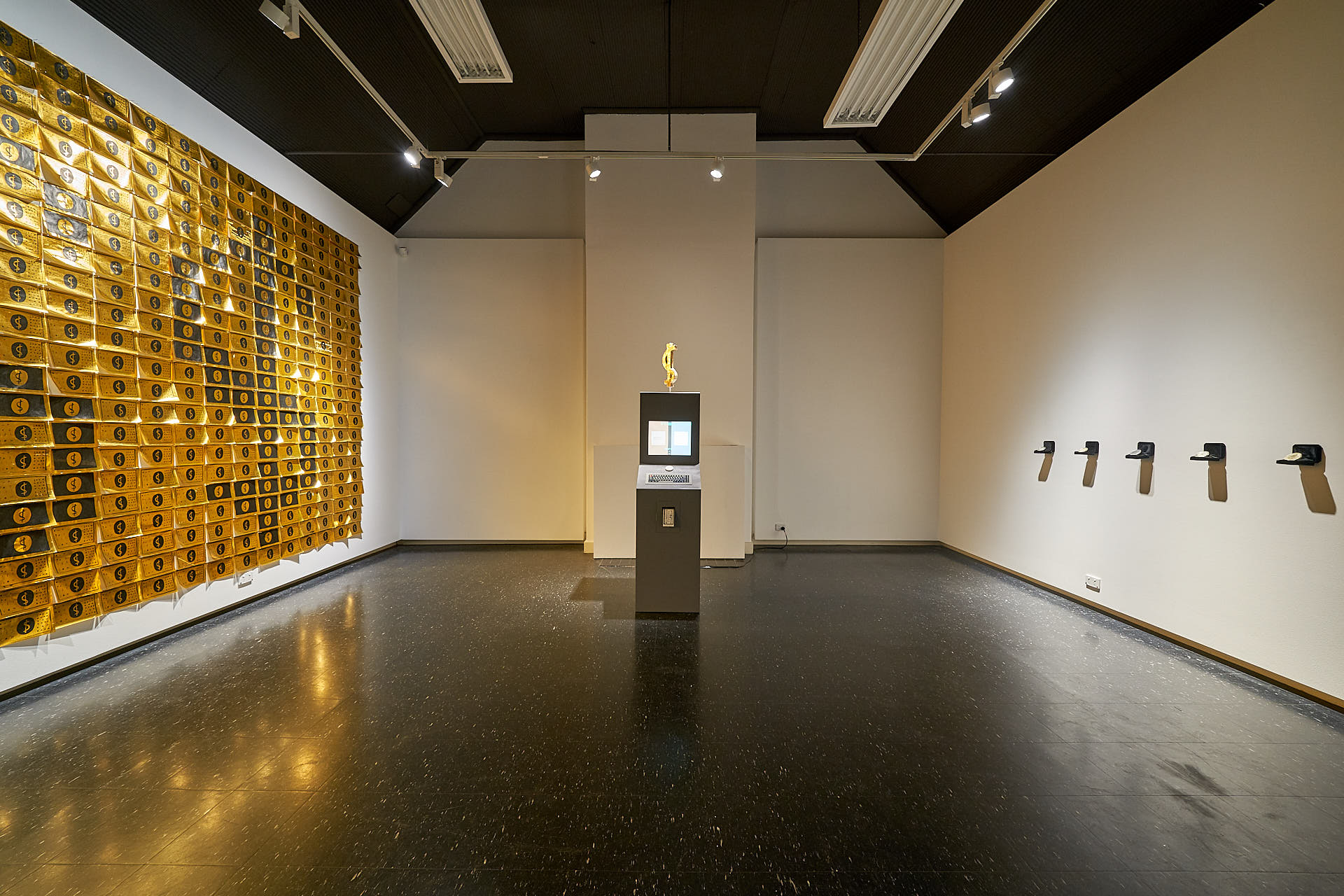
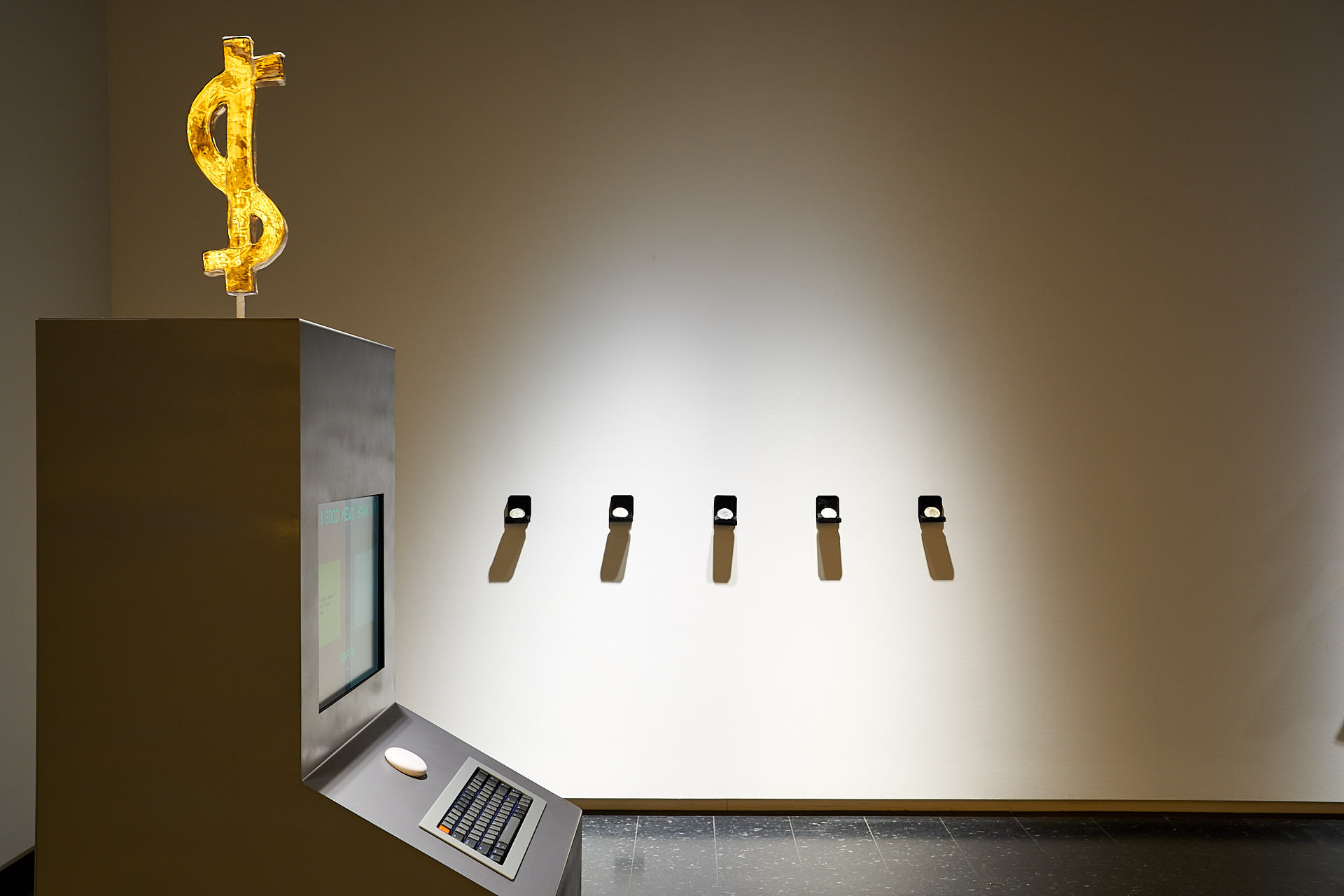
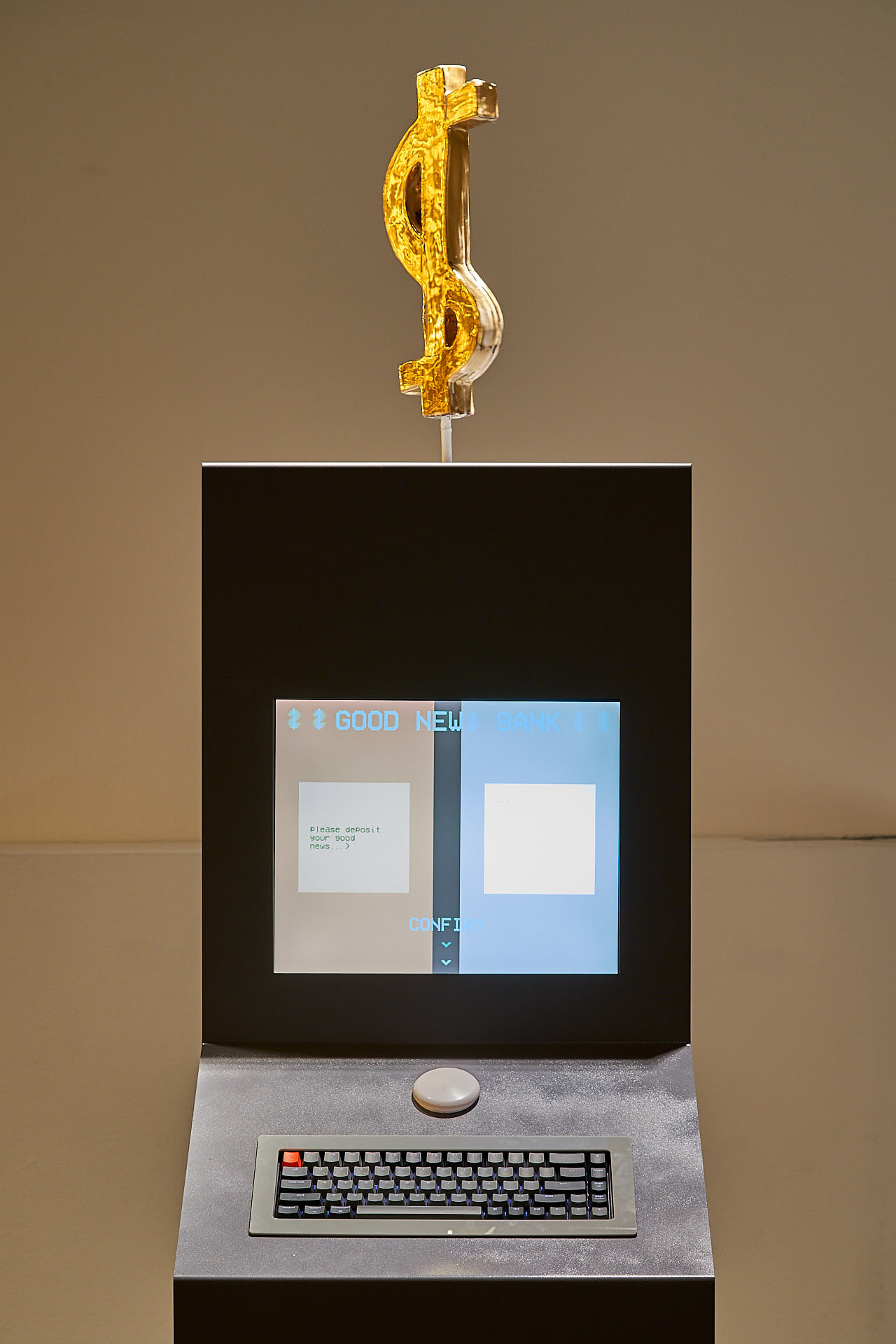
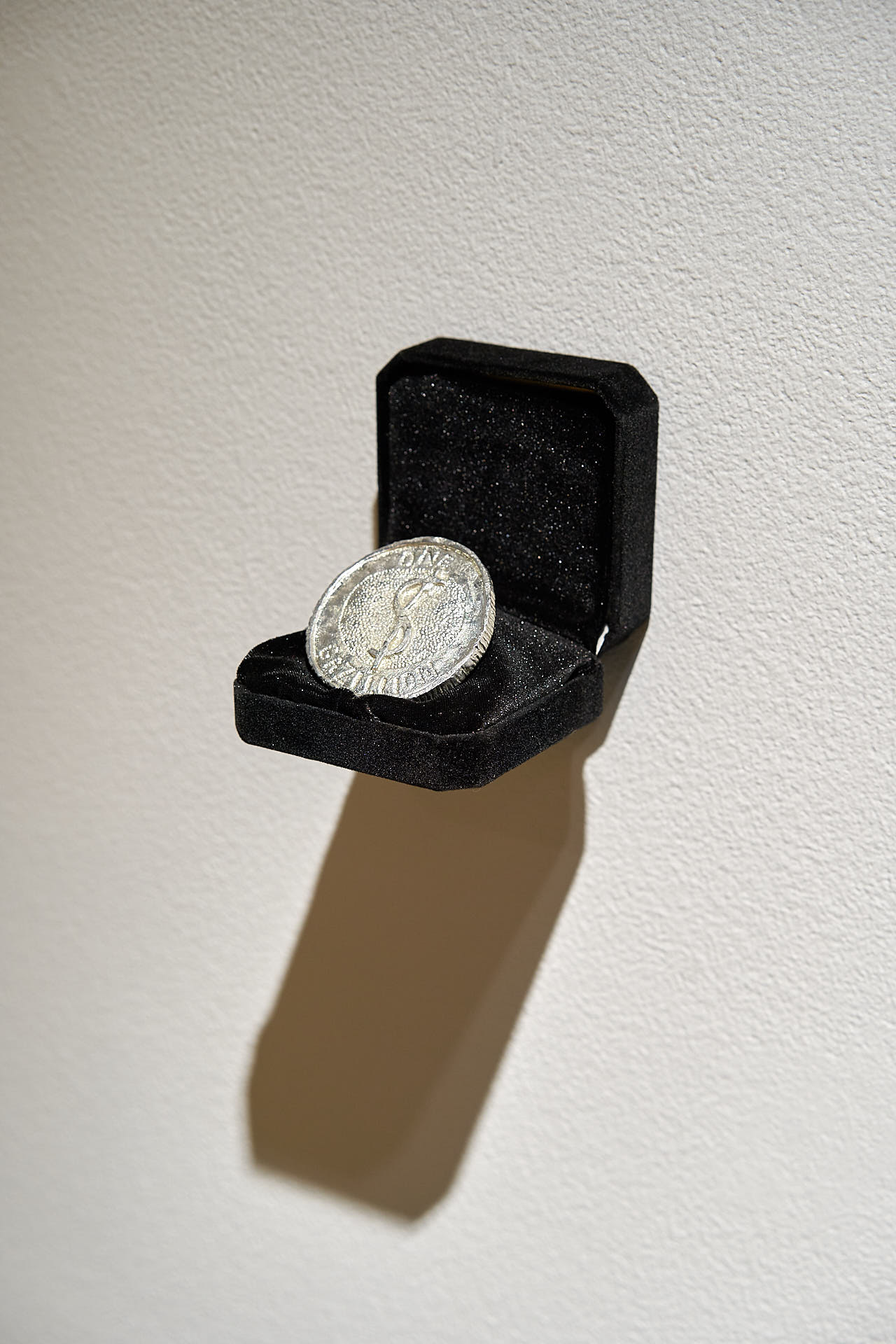
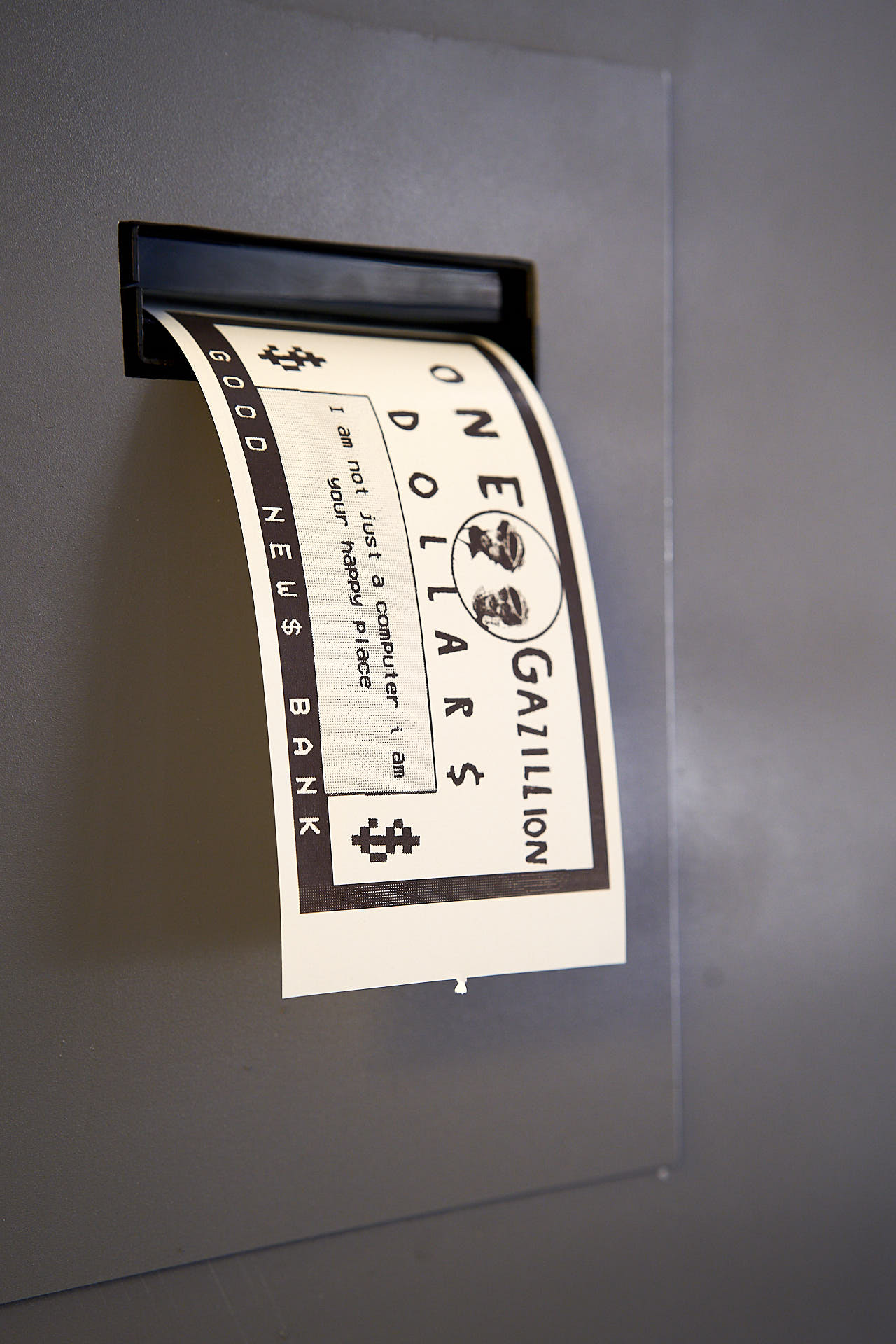
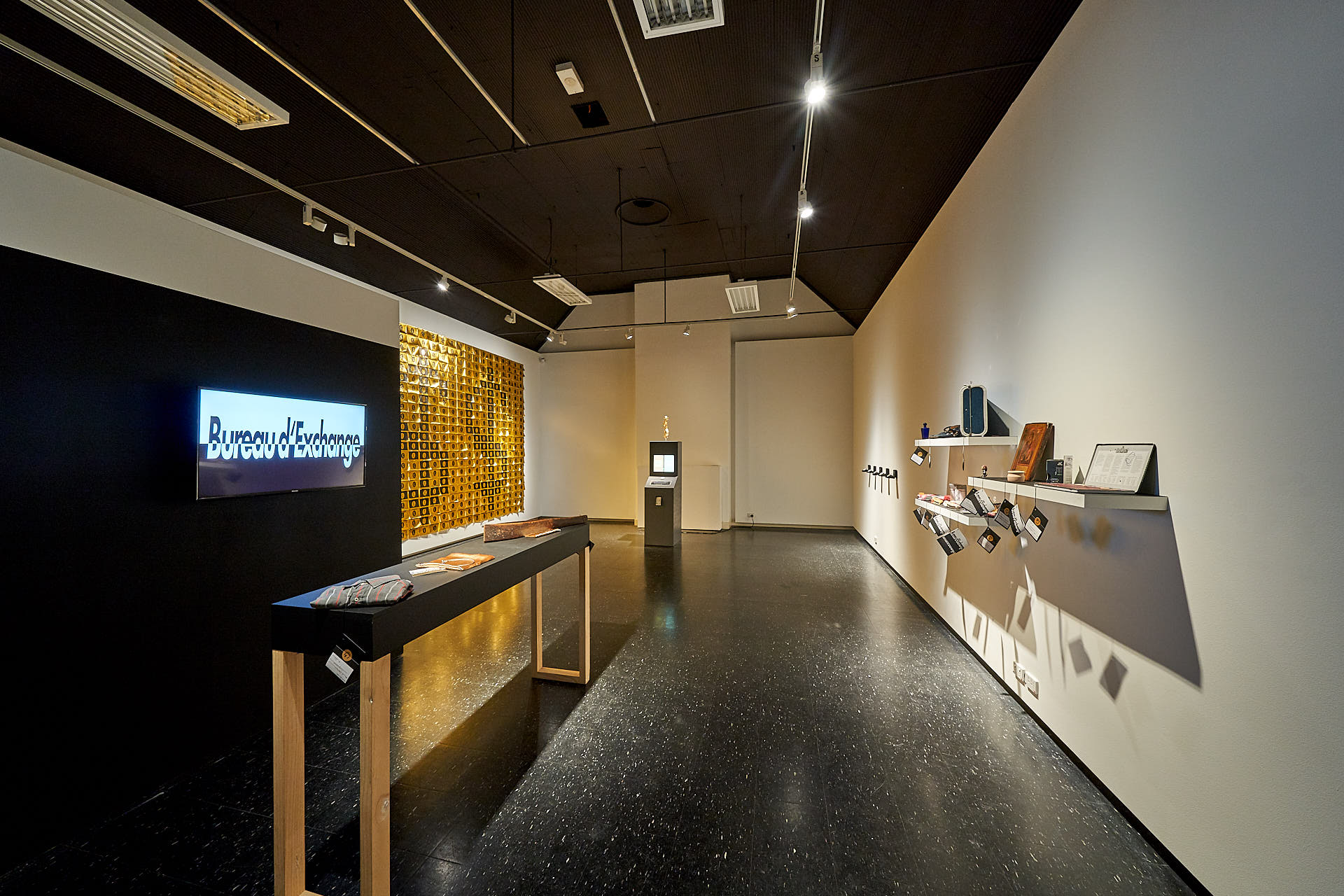
The New Money is an exhibition of contemporary visual art that contemplates alternative economic models as a basis for a post-COVID financial system. New systems of exchange based around sentimental value, artistic exposure, and other esoteric approaches to commerce are explored in a show that is fun and though-provoking! Featuring new work by Cynthia Schwertsik & Emma Beech, and Good New$ Bank (Cassie Thring & Nicholas Hanisch).
Exhibited at Adelaide Central School of Art >
“We’re told to bring an object to this art exhibition, which ostensibly looks like a room full of junk assembled around an ATM but sees us leave feeling richer than when did before entering. ★★★★½ “
Angela Skujins
Fringe review: The New Money >
Photography by Sam Roberts.
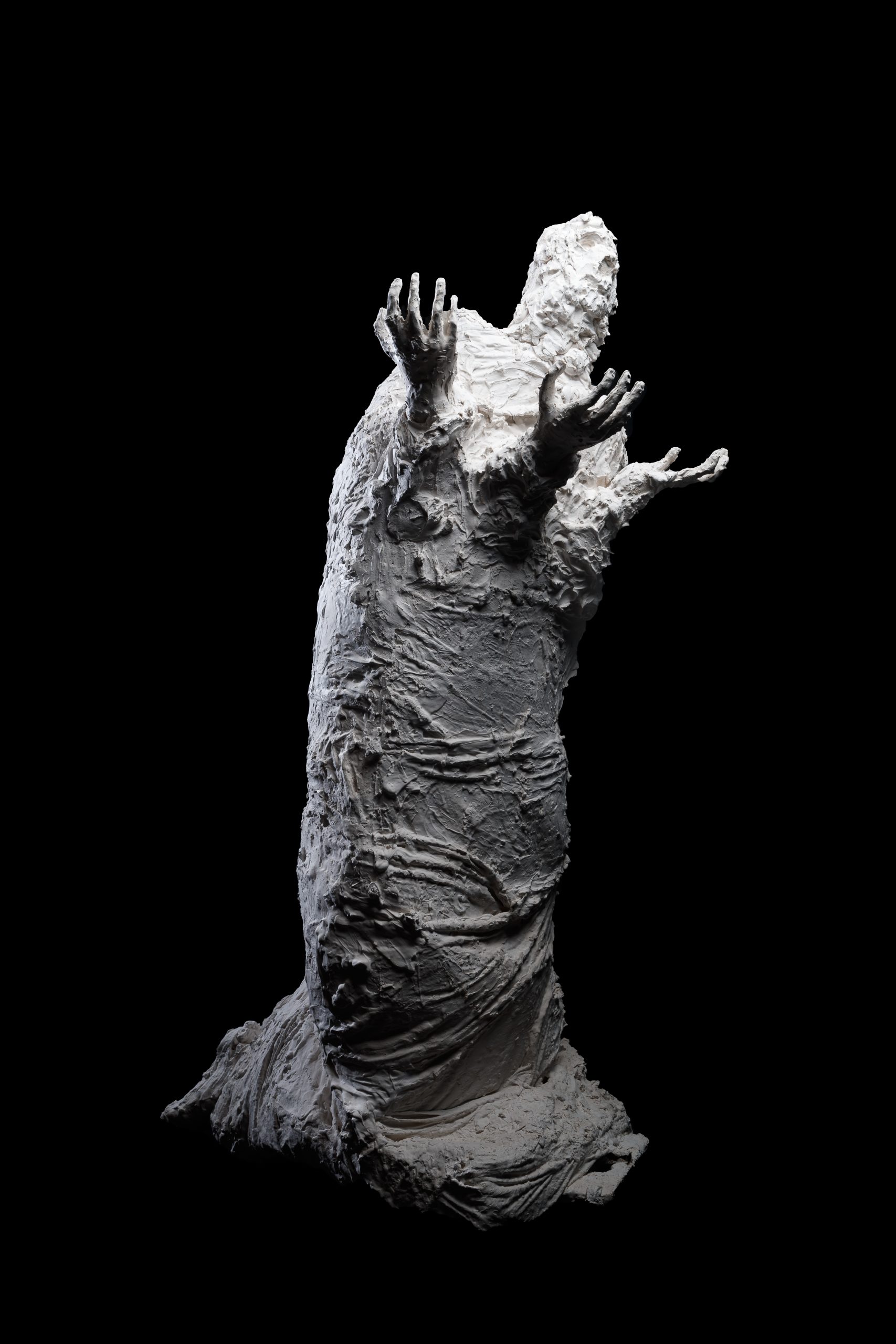
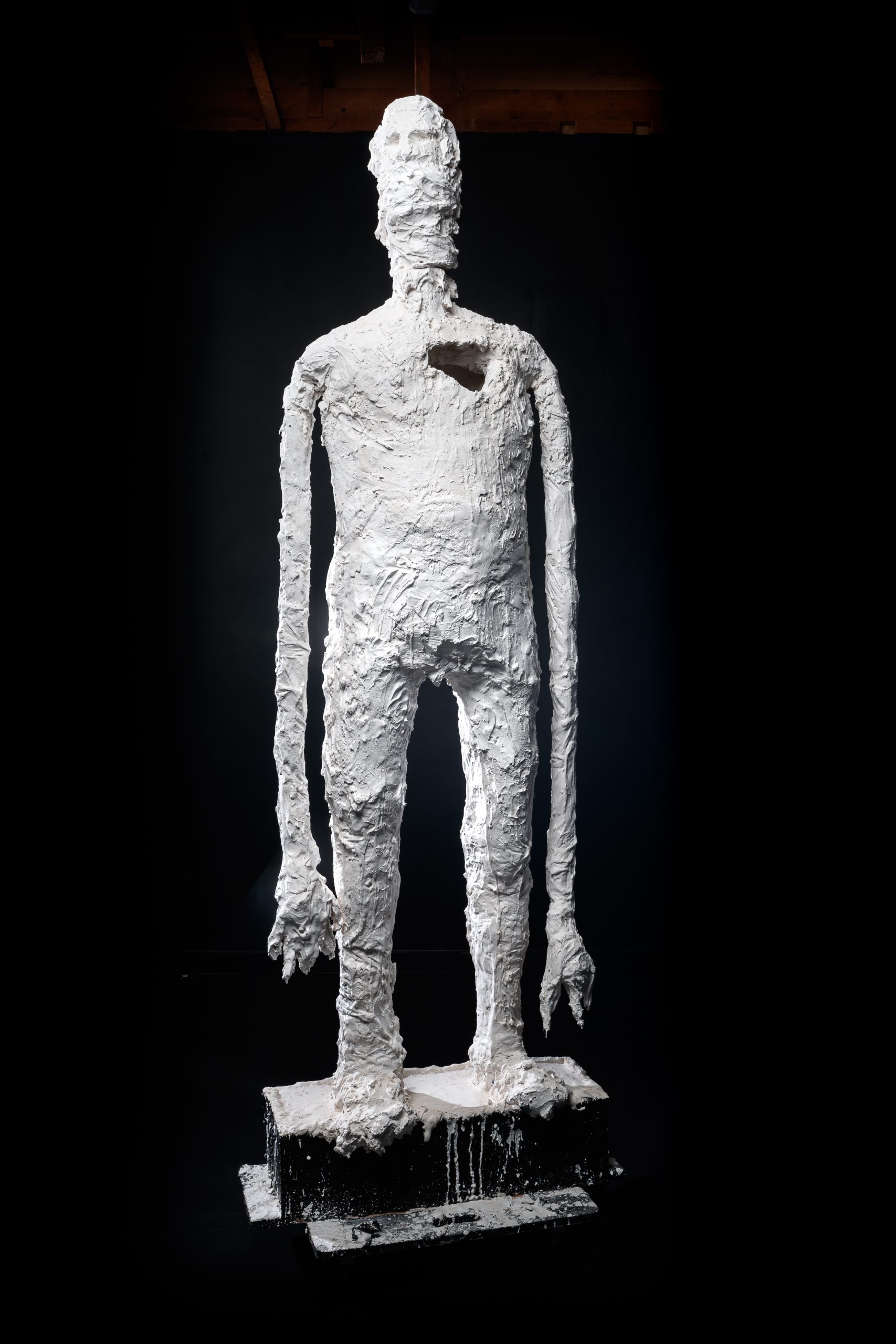

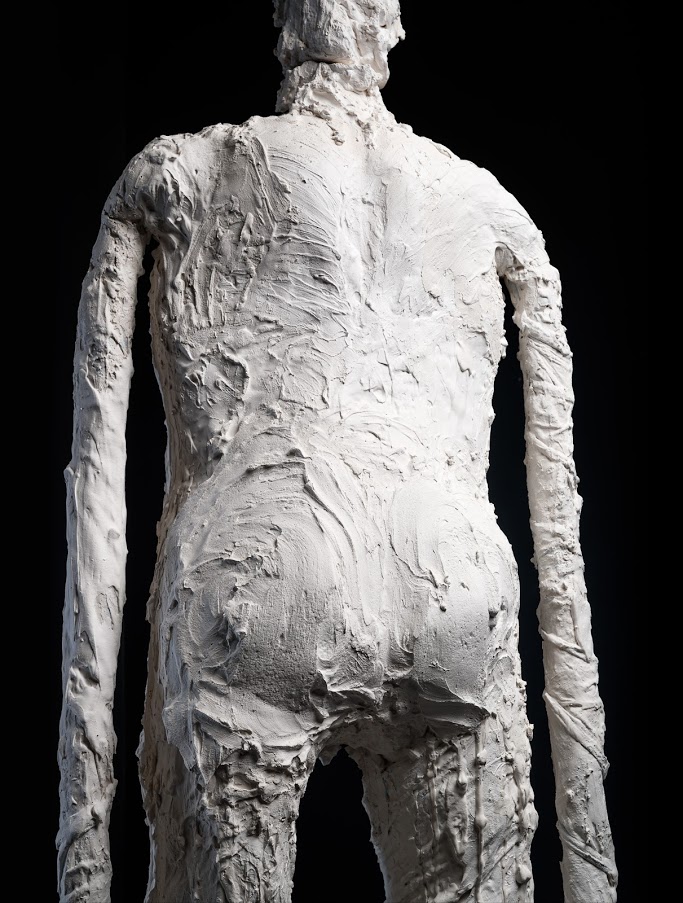


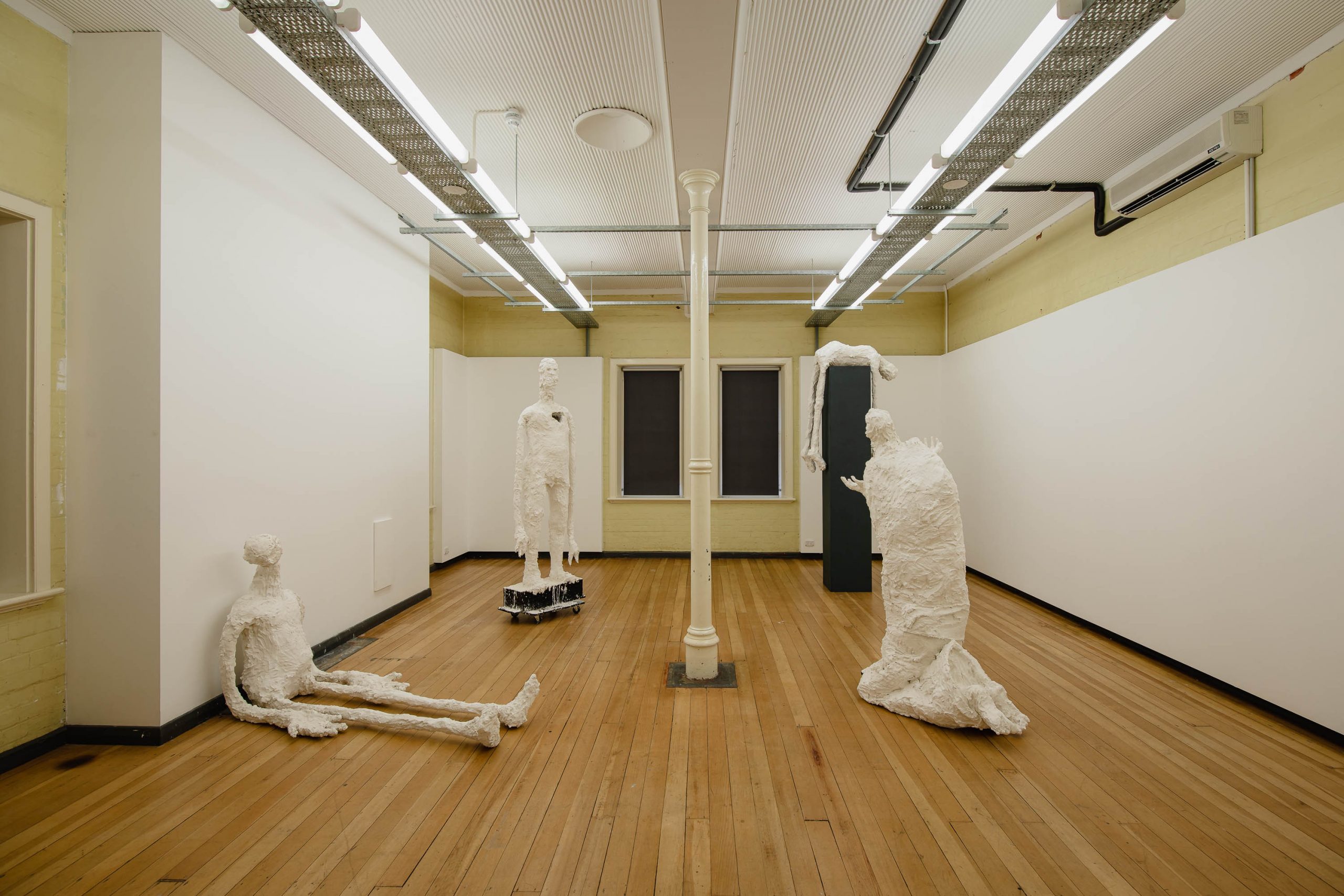
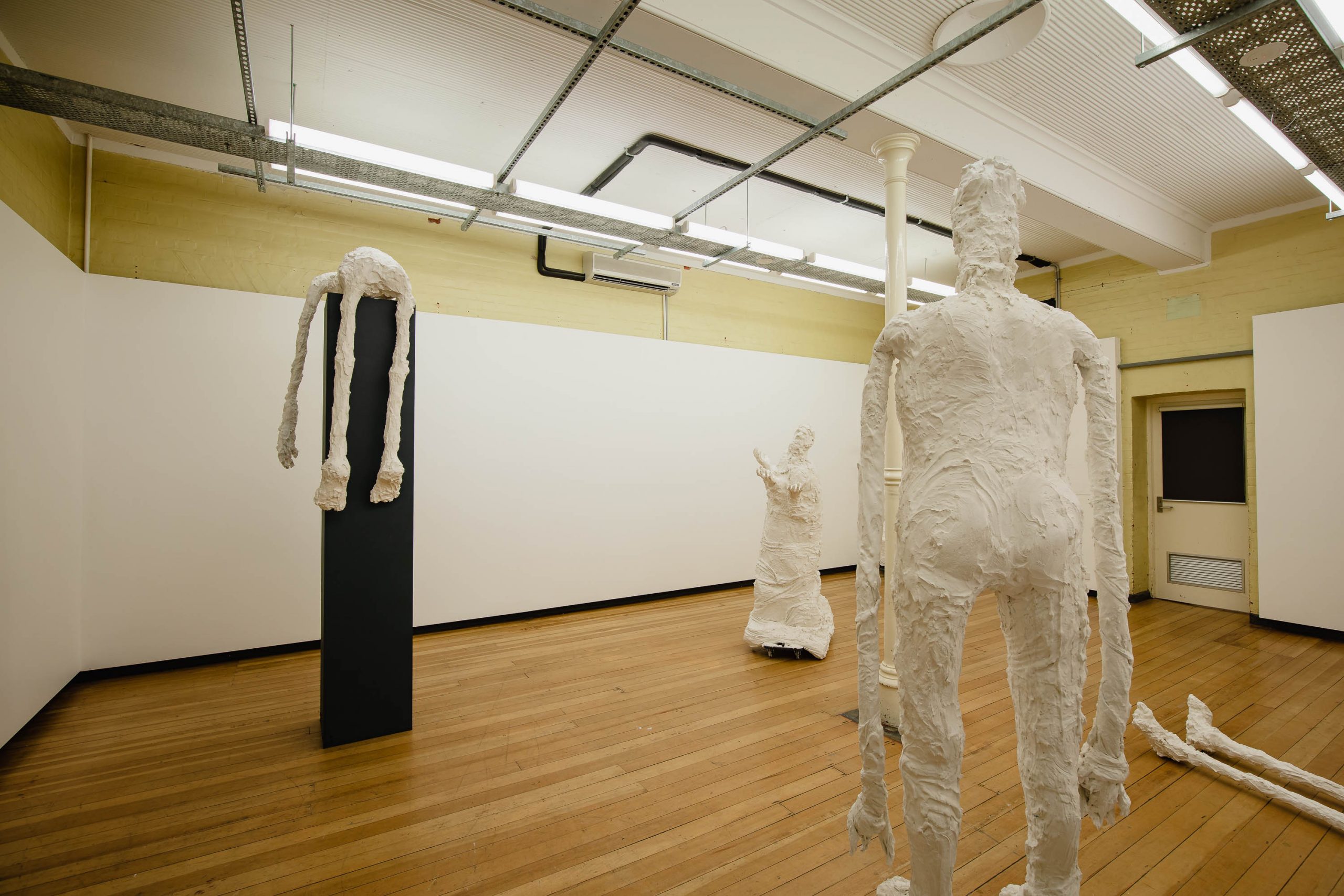
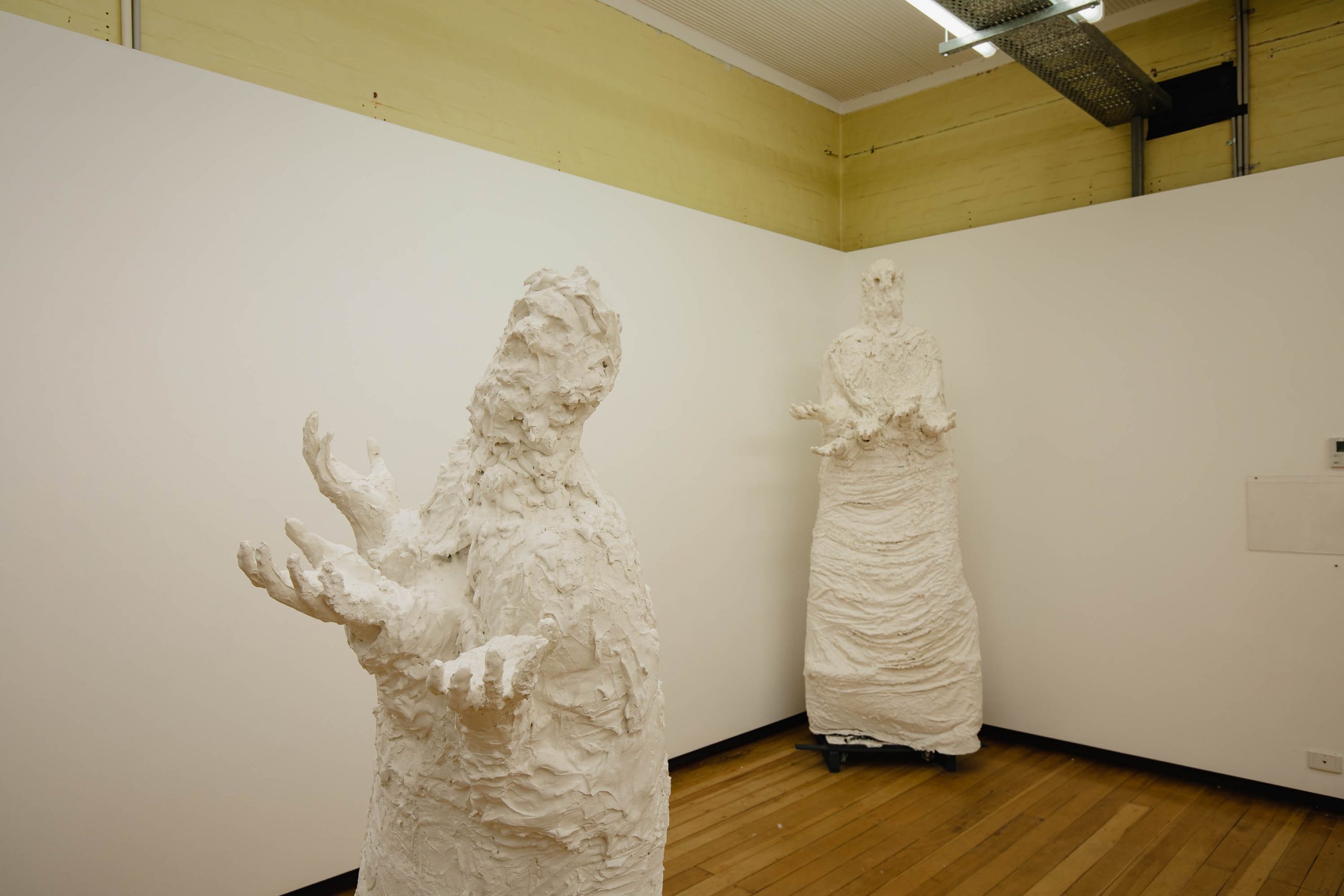
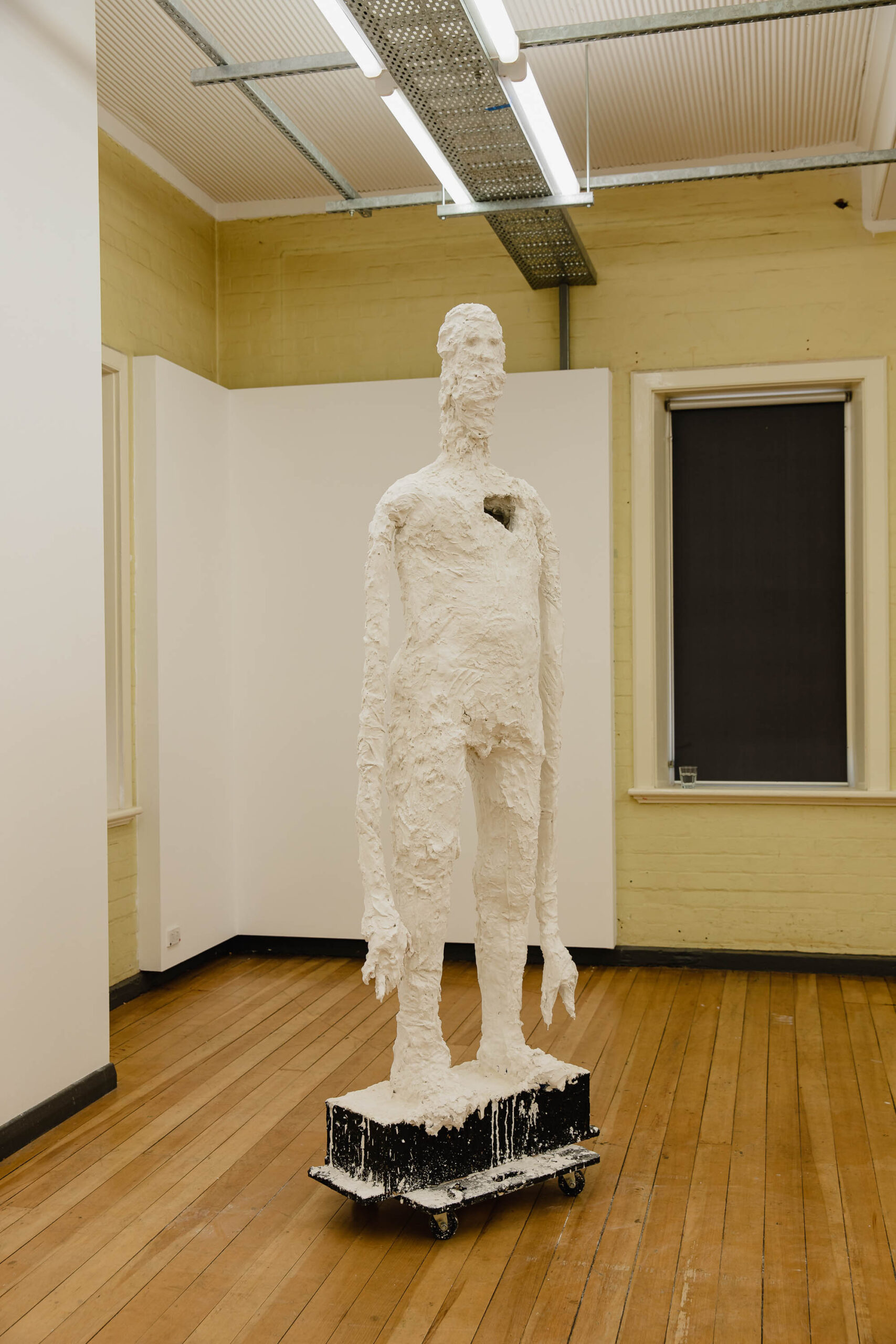
“From the primordial sludge the being is made: golem, new life, self-replicating cappuccino foam, elemental secrets, body malfunctions, leave a hole for the soul, numinous breath, desiring humanness, pack them away for a rainy day, six drops of sinister sauce, stir vigorously to remove lumps, sneeze into schnoz for desired liveliness, desperately vulnerable, crumbling effigies, it’s alive! “
Nicholas Hanisch’s recent body of work investigates creation narratives within the history of figurative sculpture, whilst celebrating the humour, the horror, the happenstance, and the sheer endeavour of creation. In his process, he focuses on ways in which to generate effectual responses in the audience, encouraging them to respond to the work as though it were a living being and react through expressions of emotion, whether that be humour, horror, or fear.
Making People: desperate endeavours to create life from primordial sludge, is a series of sculptures specifically focusing on the Jewish folktale of the Golem as well as Mary Shelley’s Frankenstein. Hanisch uses clay modelling, plaster cast reproduction, and plaster building techniques to form larger-than-life sculptures that encourage imaginative responses from the viewer as these inanimate objects become unavoidably anthropomorphic. During the making process, these sculptures constantly evolved, responded to, and adapted to their surroundings. Like Prometheus moulding man in Greek mythology or the cadaver amalgamation of Frankenstein’s Monster, Hanisch imbues his sculptures with a sense of life that aims to generate a human response with the viewer.
Further reading:
Making People: desperate endeavours to create life from primordial sludge Exegesis >
Exhibited at:
Perth Institute of Contempory Arts Hatched National Graduate Exhibition 2021 >
Adelaide Central School of Art Graduate Exhibition 2020 >
★ Selected for the Hatched: National Graduate Show 2021 at the Perth Institute of Contemporary Art.
★ Recipient of the Lee Family Award for high-achieving Bachelor of Visual Arts [Hons] graduate at Adelaide Central School of Art.
★ Recipient of the Bachelor of Visual Arts [Honours] Scholarship at Adelaide Central School of Art.
Photography by James Field.
Photography by Rosina Possingham.




a collaboration with Alex Mullen.
Sea Shanties explores the artists surreal interpretations of their global adventures through their somewhat foggy memories. Their careers have seen them live, study and exhibit in many corners of the globe – from New York City to Kashmir, and all around Europe. In this exhibition they are drawing their memories, collaborating on paintings and recreating their iconic and sentimental objects as ceramics. Sea Shanties is a dream-like retelling of stories that maybe actually happened.







“Perhaps in the world’s destruction it would be possible at last to see how it was made.”
Cormac McCarthy, The Road
My work is looking at the process of building a world and the imaginary steps required to bring it to life. I am the creator and destroyer of my world, and by providing the viewer with a catalogue of broken landscape forms, I am inviting them to piece it back together. My works are not intended as a complete map to follow but rather snapshots of a journey, a guide for the viewer to forge their own path. These fragments could become a list of pieces to choose from, or a travel brochure showing small parts of a larger whole.
Uncharted Territory
Exhibited at Adelaide Central School of Art.

One Hundred Extra Lives is a showcase of three South Australian emerging artists (Nicholas Hanisch, Bonnie Lawson, Madeleine Stentiford) and their adventures through imaginary worlds.
As our world has become increasingly globalized and media-driven, escapism has become more popular than ever. Yet while we are on the cusp of a science fiction reality, it is the past and nostalgia that we increasingly harken to. One Hundred Extra Lives is a celebration and deconstruction of imaginary worlds, fictional tropes and our obsessions over the paracosms of others.
Image: Paracosmalia, 2014, oil on canvas.

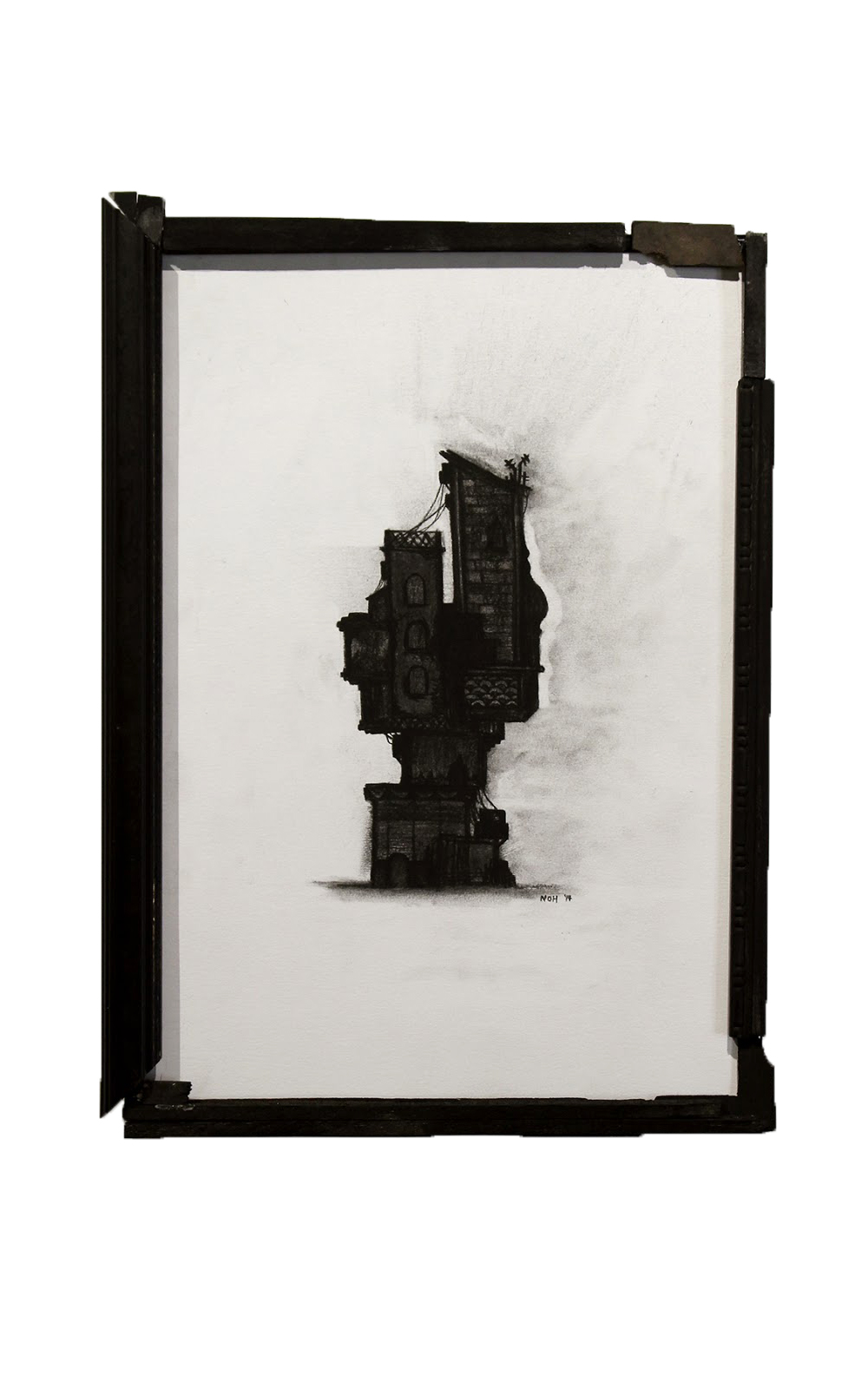
exhibited at Adelaide Central Gallery.
After experiencing the chaos of Indian cities, I became fascinated by the band-aided architecture and the jumble of old and new imagery. The way ancient buildings are sprouting hi-tech gizmos, and holy symbols are painted next to mobile phone advertising. Cows graze in front of Lamborghini shops. This constant clashing of progression inspires almost dystopian fantasies, where fresh societies are rebuilding into the shells of their predecessors. Their new habitations are fusing with the former landscape.
With a spring in my step is an exhibition of new work by 6 recent graduates from the Adelaide Central School of Art, timed to coincide with the Adelaide Fringe Festival; an exciting and enjoyably frantic time in the South Australian calendar as thousands of people crowd into or around numerous shows, events, exhibitions and pop-up performances.
Also exhibited as part of Empiricism
Exhibited at Peter Walker Fine Art.
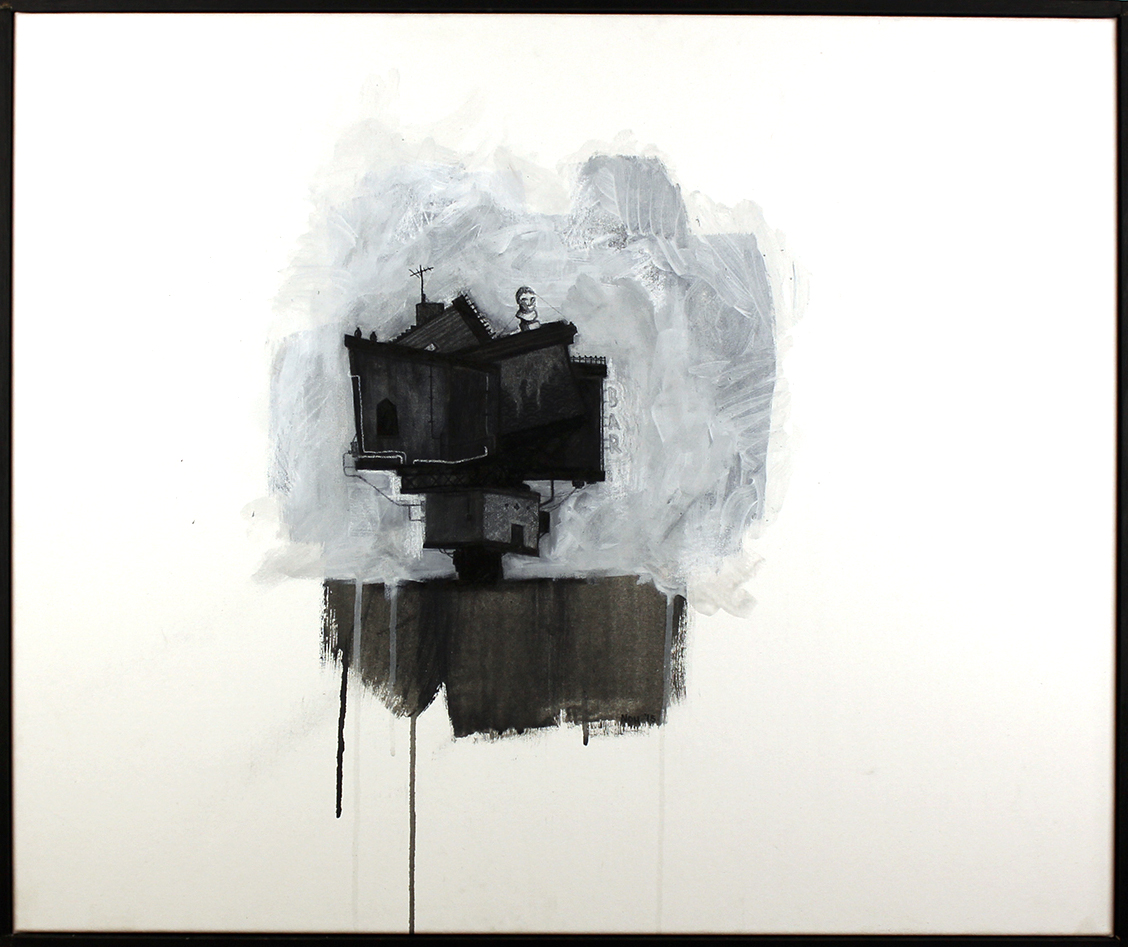

exhibited at Floating Goose Studios 2015.
The 8th fold is a showcase of four emerging artists working and living in South Australia, (Nicholas Hanisch, Alison Thomas, Jonathan George, Pedro Shi). The themes of each artist are varied yet complementary, exploring worlds of beautiful decay through prisms of politics, nature, neurology and the realms of a dystopian universe
Nicholas Hanisch is an emerging South Australian artist whose practice explores imaginary places and dystopian futures. Focusing on drawing and sculpture, his work captures pivotal moments in otherwise unexplained fictional worlds. These drawings represent impossible architectures, built to withstand and preserve their habitations against their hostile environments.
The 8th Fold >
Untitled, 2015, various wood, paint, fluoro lights.
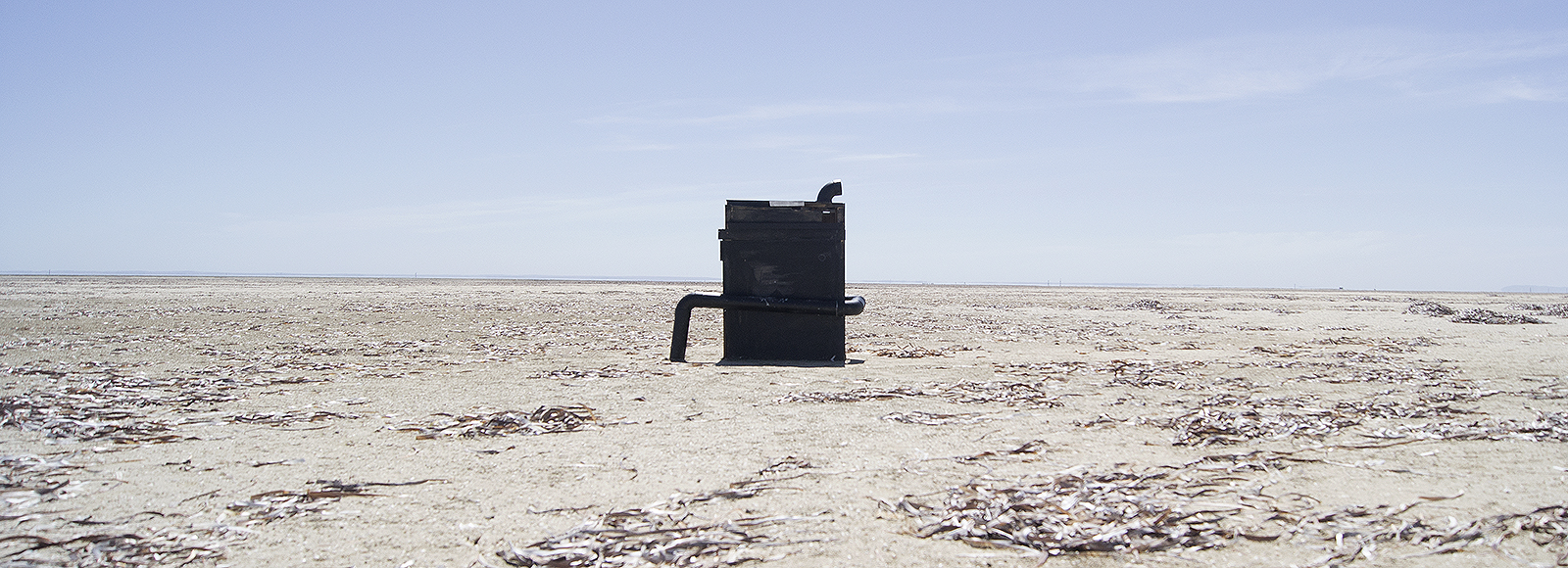
exhibited at University of Jammu in India 2016.
Artists Under the Great Sky was a group exhibition held at the University of Jammu in India. Three members of the Floating Goose Studios joined with Indian, Pakistani, and Lithuanian artists to exhibit their artworks on an international stage.
Untitled, 2015, various wood, paint, fluoro lights.
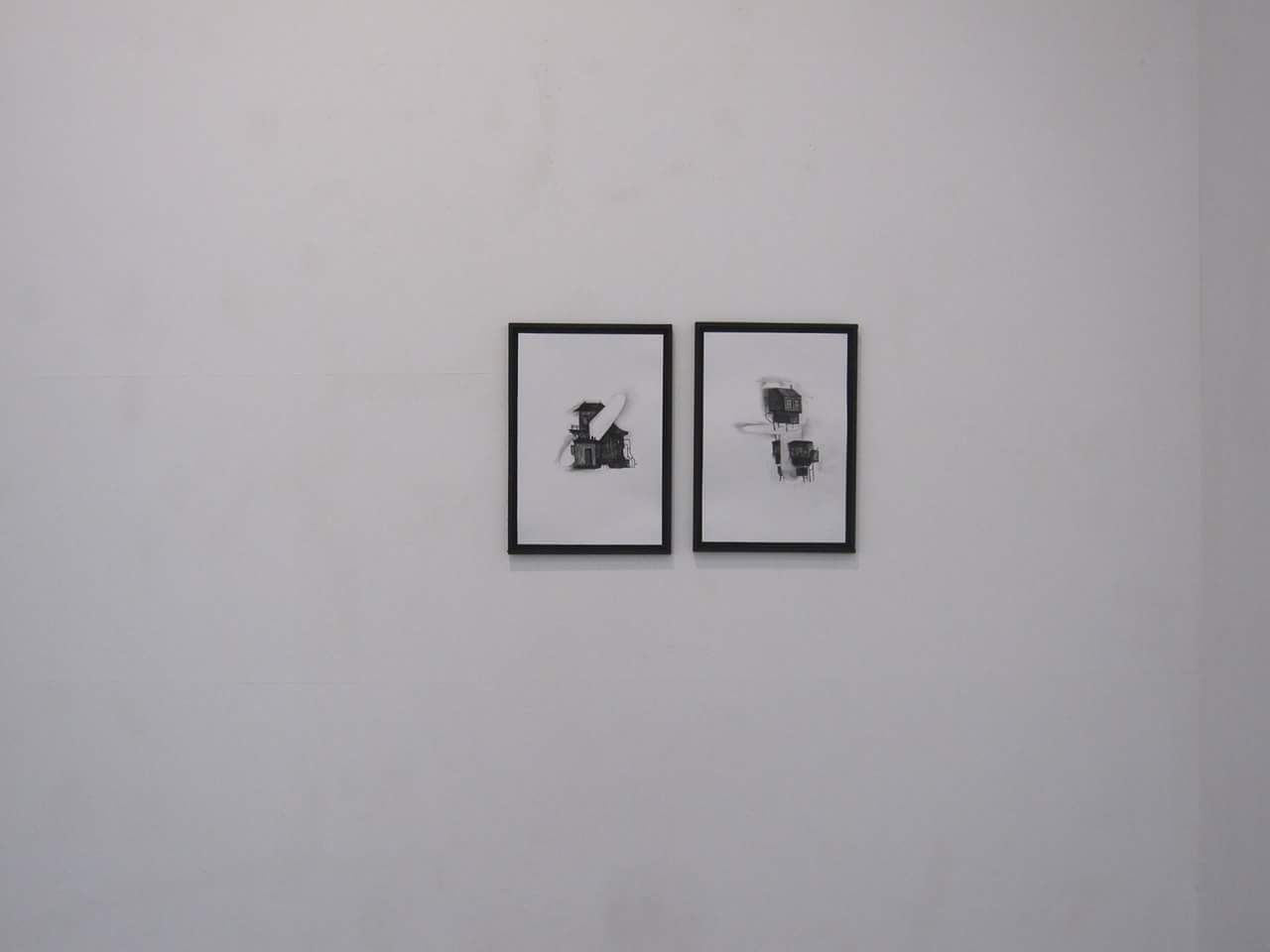

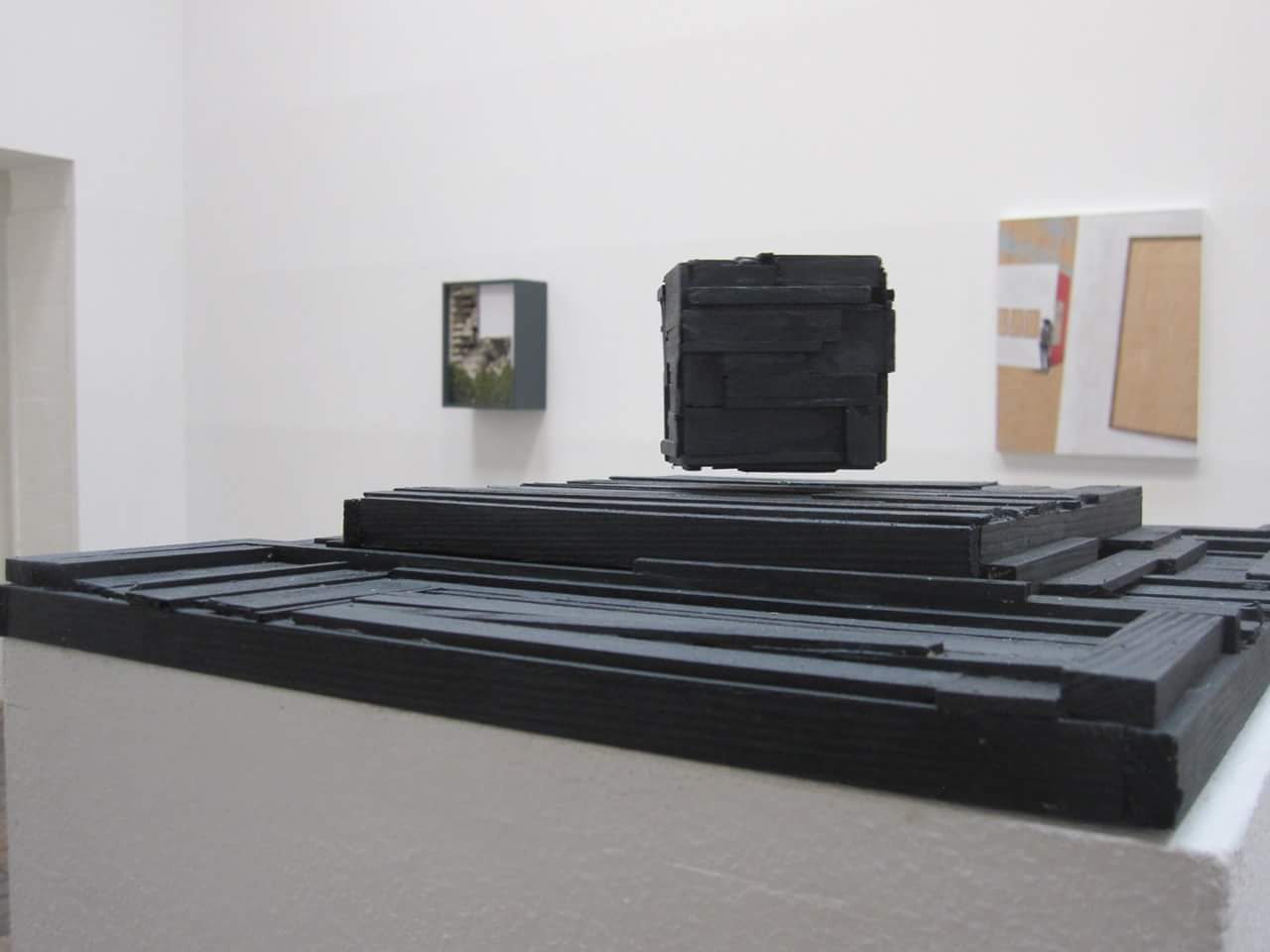

Curated by Sheena Malone.
Artists: Pascal Brateau, Pierre Oscar Brunet, Chris Dennis, Nicholas Hanisch, Michel Lamoller, Enda O’Donoghue, Eeva-Liisa Puhukka, Ethna Rose
April 1, 2017 – May 13, 2017
Transitions is an exhibition series evolving during the 2017 season at Dada Post, a project space located in a former fish smokery in Berlin Reinickendorf.
Rather than acting as separate entities, the four episodes in this series are to be viewed as one exhibition which changes over time; each iteration flowing into and drawing from the other. The exhibition begins firmly rooted in the physical world with artists employing motifs that refer to both built architecture and invisible social constructs. As the exhibition unfolds, the unexpected fragility of these frameworks is questioned. This splintering and fragmentation leads to the excavation of other paths which may reveal less tangible worlds where materials take on new meanings and unexpected juxtapositions may be encountered.
Transitions Ep.1: Splintered Planes >
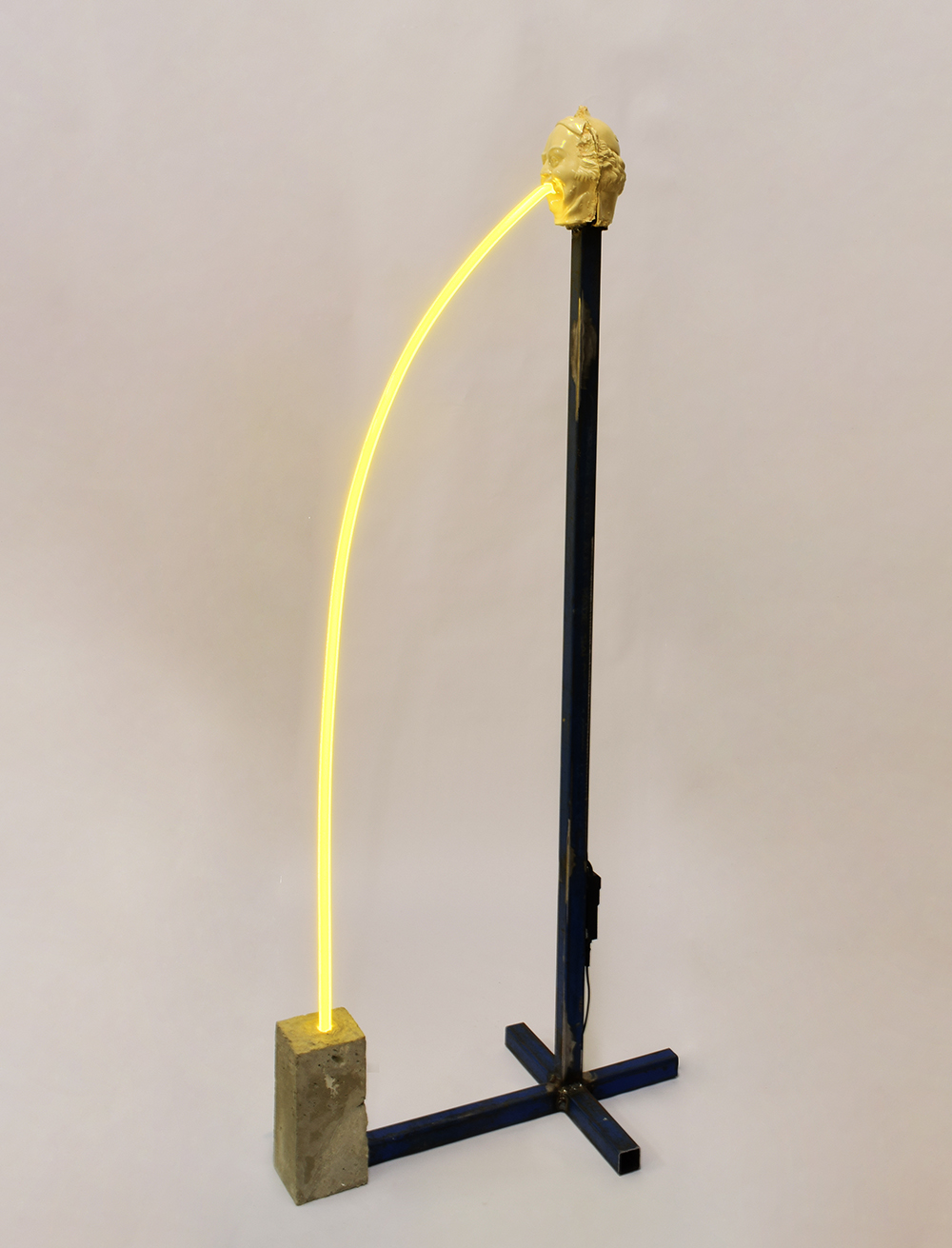
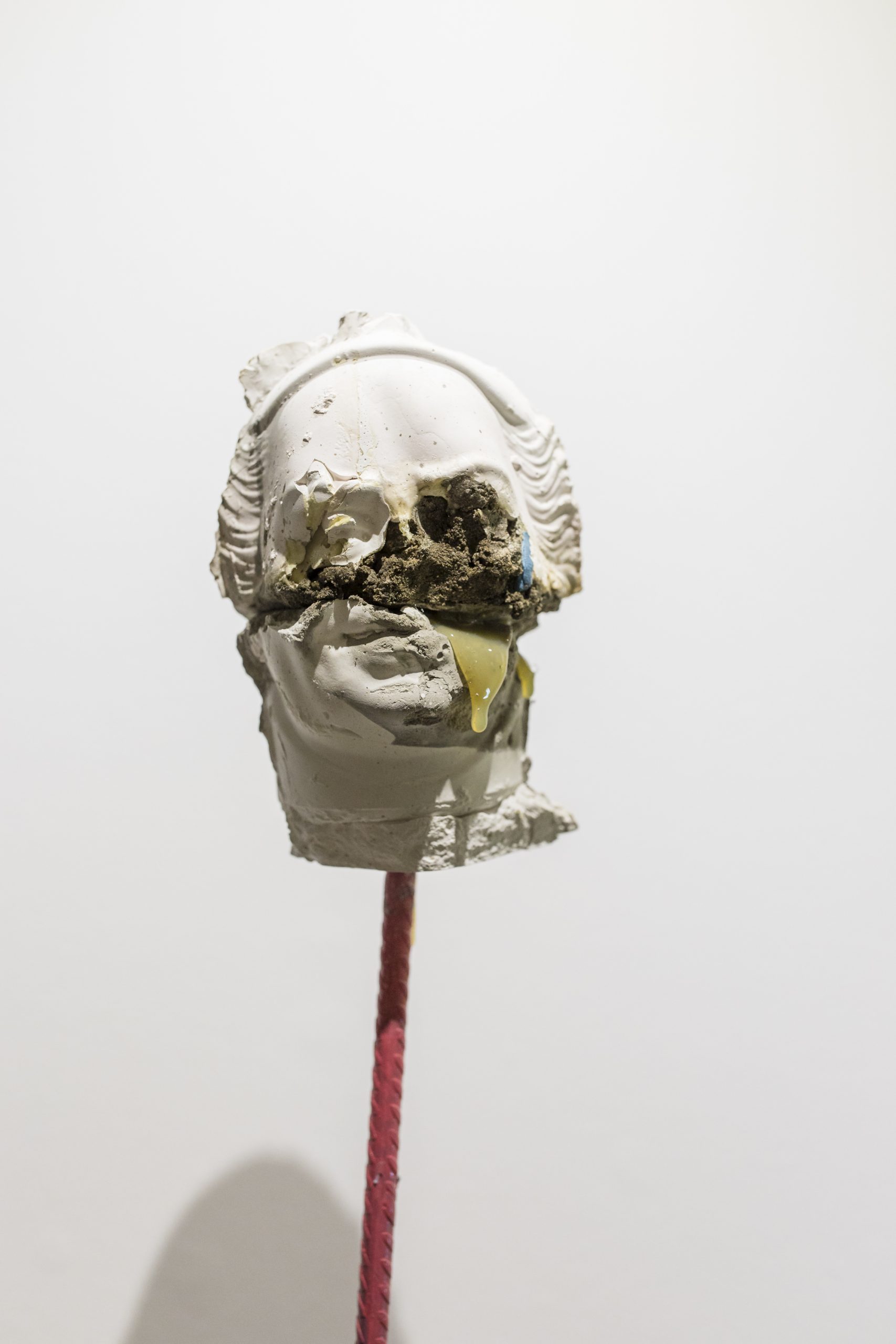
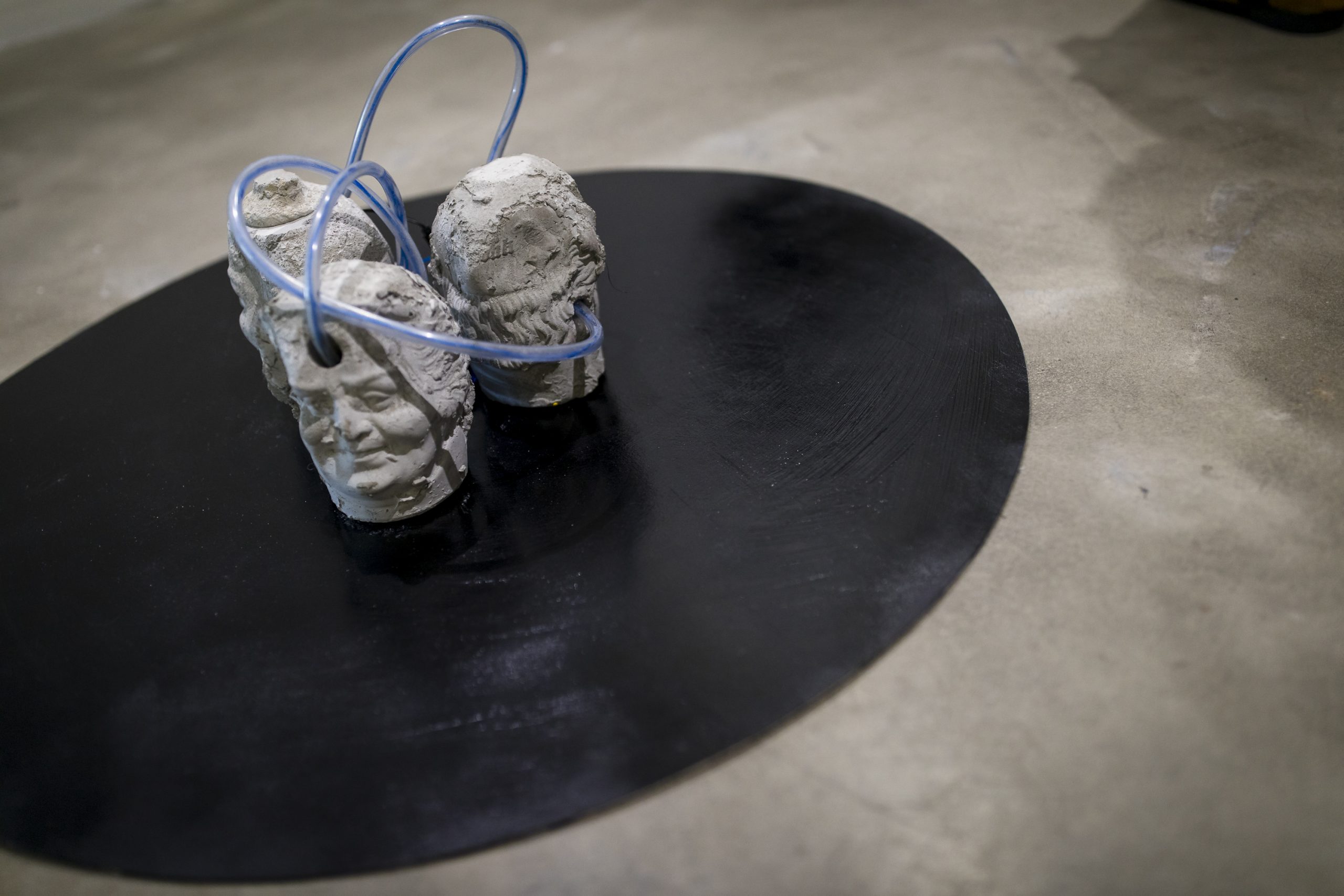

Exhibited at Floating Goose Studios
A one-eyed octopus in the depths of the primordial ocean wraps one grasping tentacle around a bottle of doctor pepper, weathered beyond recognition by the motion of water and the passage of time. In the distant future, a hyper-evolved intelligence, long ago having abandoned the inconvenience of corporeal form, recreationally ponders the function of legs. It is from this inquisitive and somewhat detached position that Nicholas Hanisch embarks upon his existential quest to uncover what it is to be human in the sculptural installation entitled People Machine.
Upon entering the gallery we are confronted with a chaotic array of semi-mechanical contraptions. Multicoloured disembodied heads spew forth a fluorescent glow or rotate spasmodically in our general direction. The walls are scrawled with inanities, the dictums of a crazed scientific mind who, without ever experiencing what it is to be human, is attempting to resurrect our species under the strictures of laboratory conditions.
The plump and bemused head that becomes Hanisch’s avatar is equally a representation of humanity as a whole, and as a stand in for the artist himself. This icon of humanity is stripped of its individuality through the process of cast mold reproduction. Humorously an attempt is made to restore that individuality to the mass produced and ready-made human substitute by subjecting it to to various processes. It is squashed, sliced, shrunken, and impaled; in one instance conjoined through a telekinetic beam, and in almost all cases painted with garish hues.
In many ways the basic premise of Hanisch’s work is an attempt to come to terms with the self through a frame of reference of the other. To use his own words, “to dissect what it is to be human, through a lens of something that isn’t”. Although this “something that isn’t” is never specified by the artist, we gain a sense of its persona through the haphazard way that it goes about investigating humanity. We are invited to conjure in our minds some ethereal being or galactic slug; something that is entirely foreign to our own experience and conception of reality. It is in fact through the failures of this imperceptible other to successfully emulate something essentially human that we gain such a strong impression of its character.
For Hanisch this hypothetical narrative operates in governance of the act of making. His material choices reflect a play between the eternal humanism of classical sculpture, the pragmatic brutalism of the construction site and the pseudo-technological spectacle of low budget science fiction. Each work is analogous to an aspect of human experience, something the artist considers indispensable in coming to terms with an overarching conception of “us”. However, with each of these aspects presented in isolation a profound absurdity becomes apparent. Perhaps we are to understand that a humanistic understanding can only come about from a holistic approach that encompasses the inherent contradictions in our character as a species. Perhaps it is an acknowledgement of our inability to faithfully represent the human condition in the artificial conditions of the gallery. Perhaps, as at the outset I first speculated, Nicholas Hanisch really is an octopus.
What we can truly draw from People Machine is that any attempt to present an overarching concept of humanity will be inherently be fraught with over-generalization. The installation we are presented with is an intentional representation of the failure of such an experiment and the absurdity that results when an attempt is made to isolate or categorise the multifaceted and fractal nature of the human condition.
an essay by Andrew Clarke.
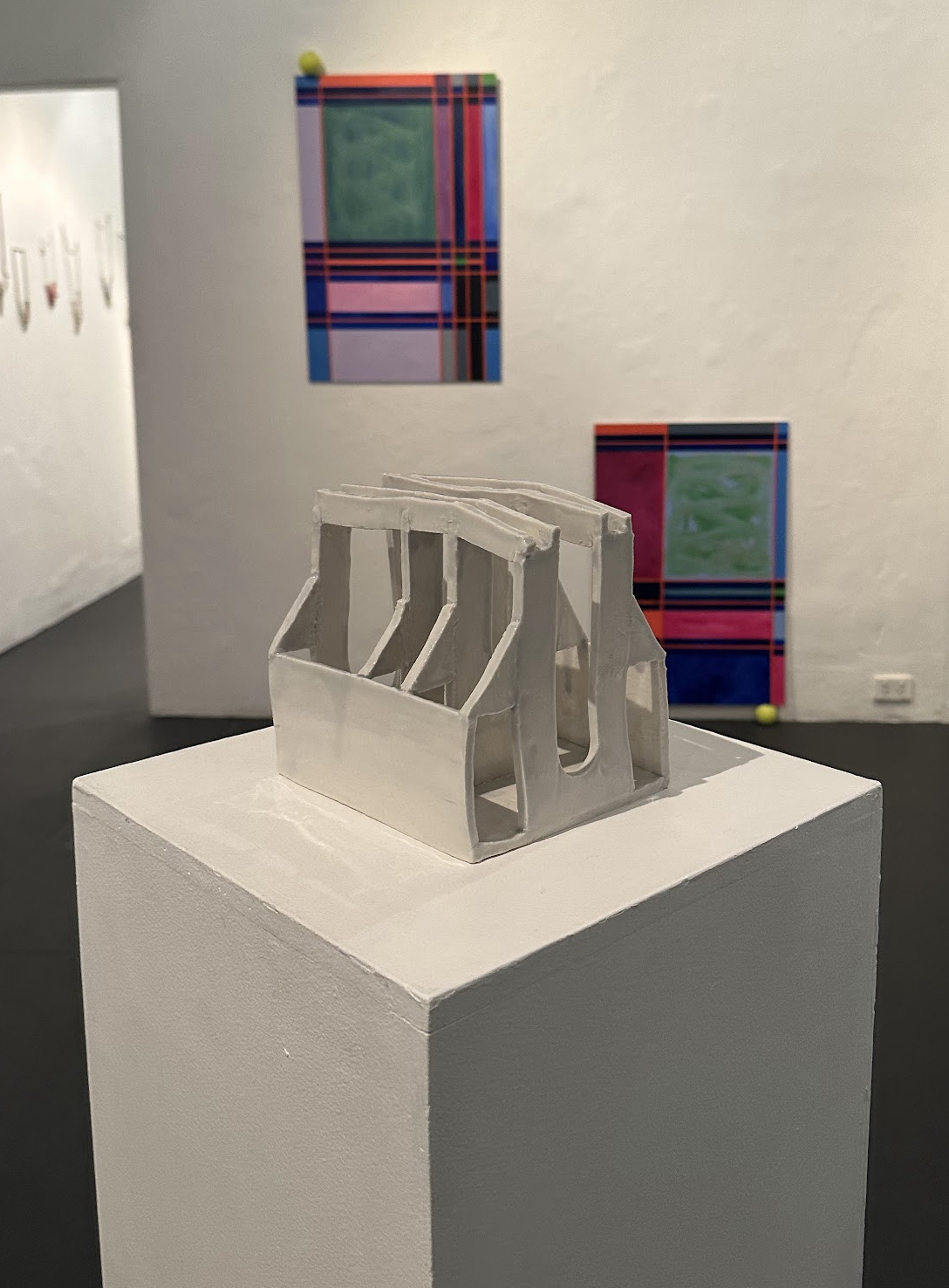
Lorem Ips
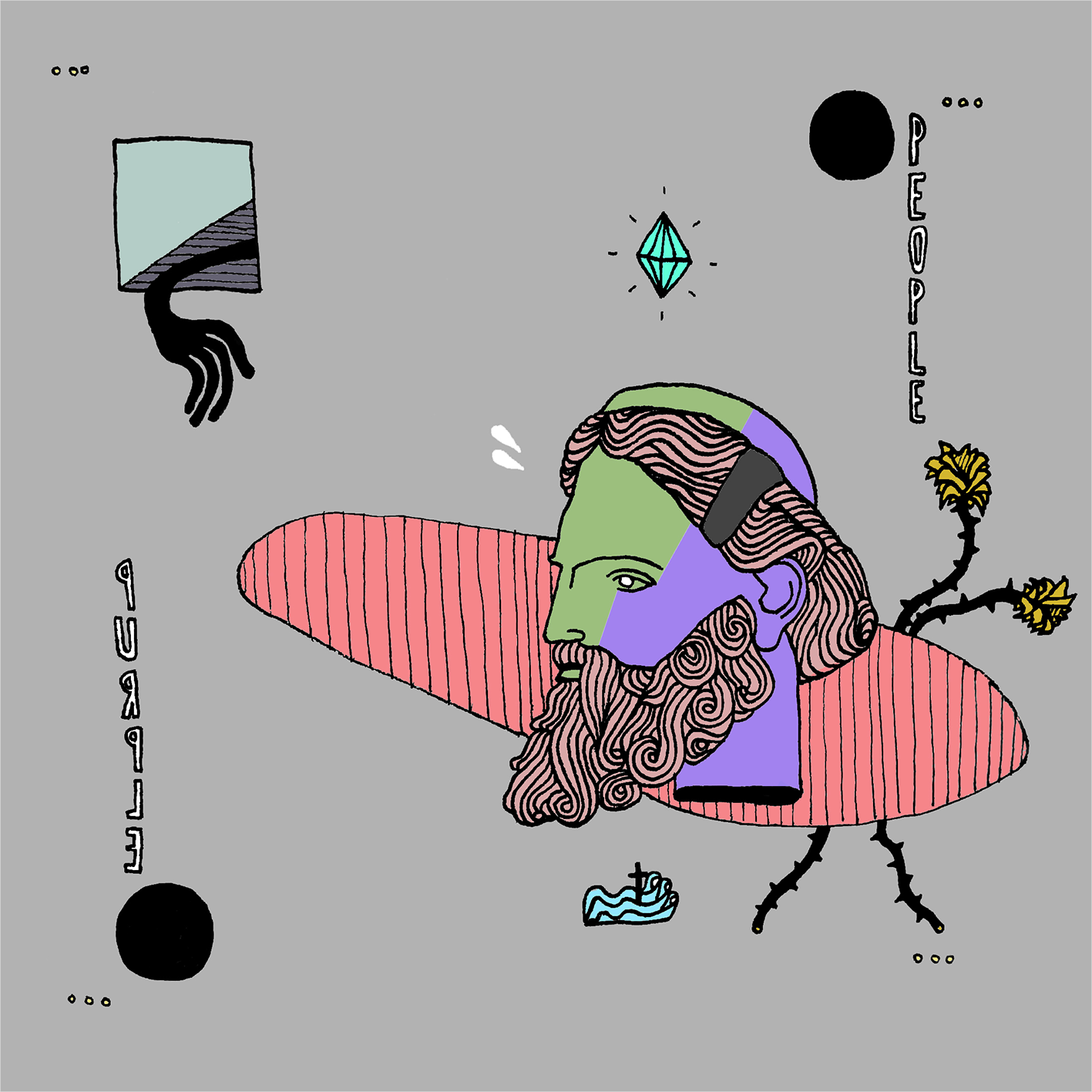
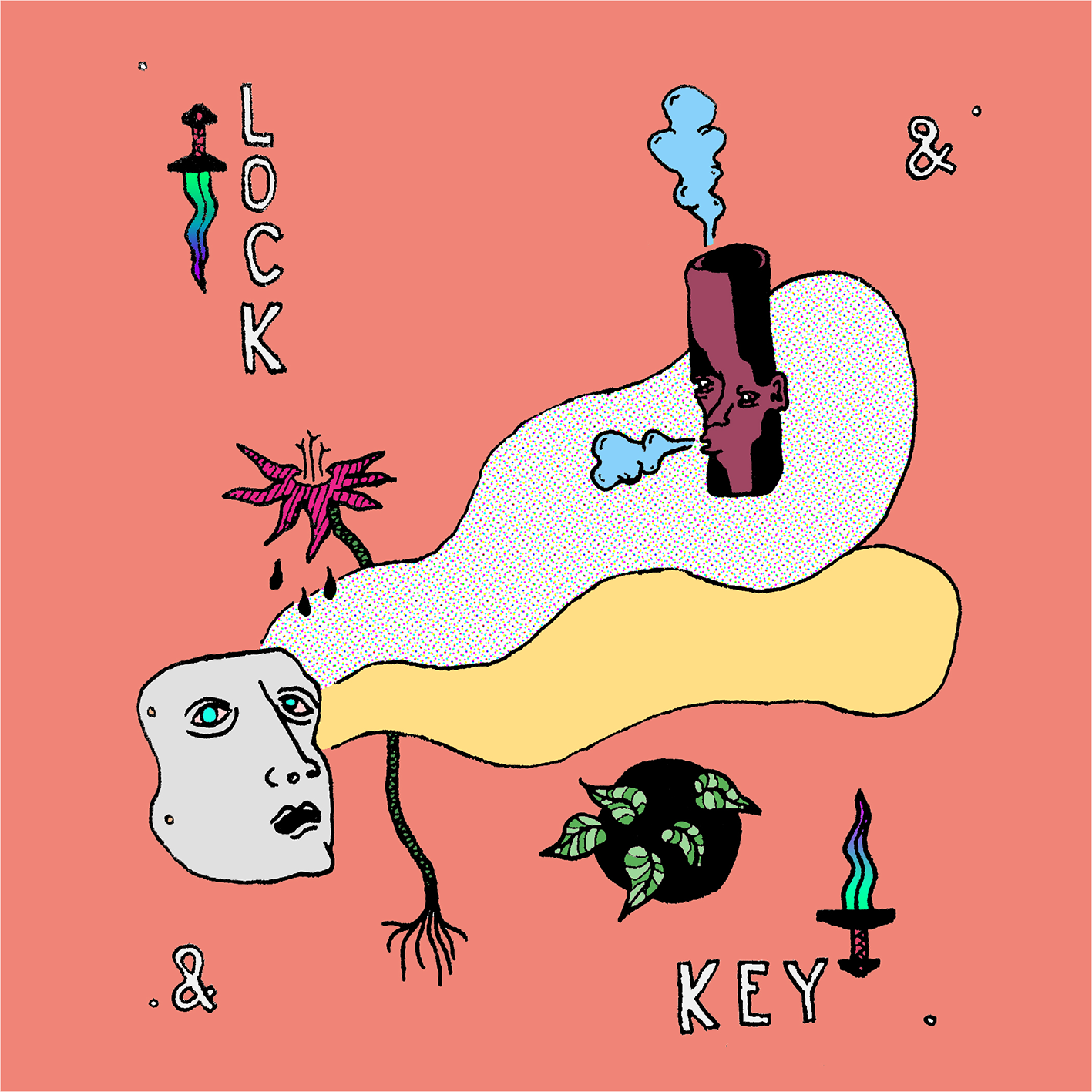

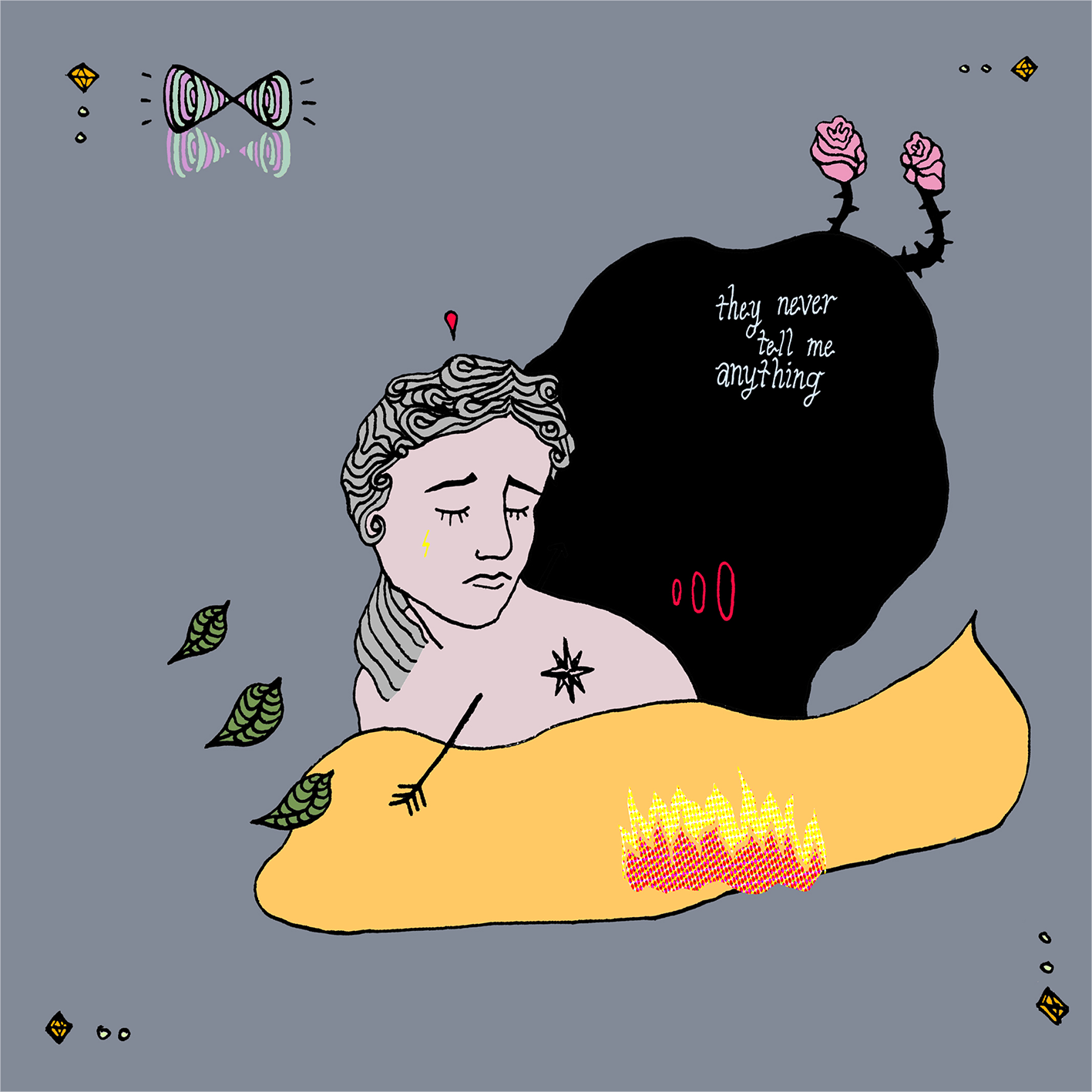
Vivid verging on disorientating, humourous and often strange, the works in this exhibition might be considered extrapolations from our world, isolated moments filtered through the artist’s own unique lens. Otherworldly with a hint of the familiar, ‘Rocket Science’ present a multifaceted vision that is both alluring and repellent, simple yet arresting.
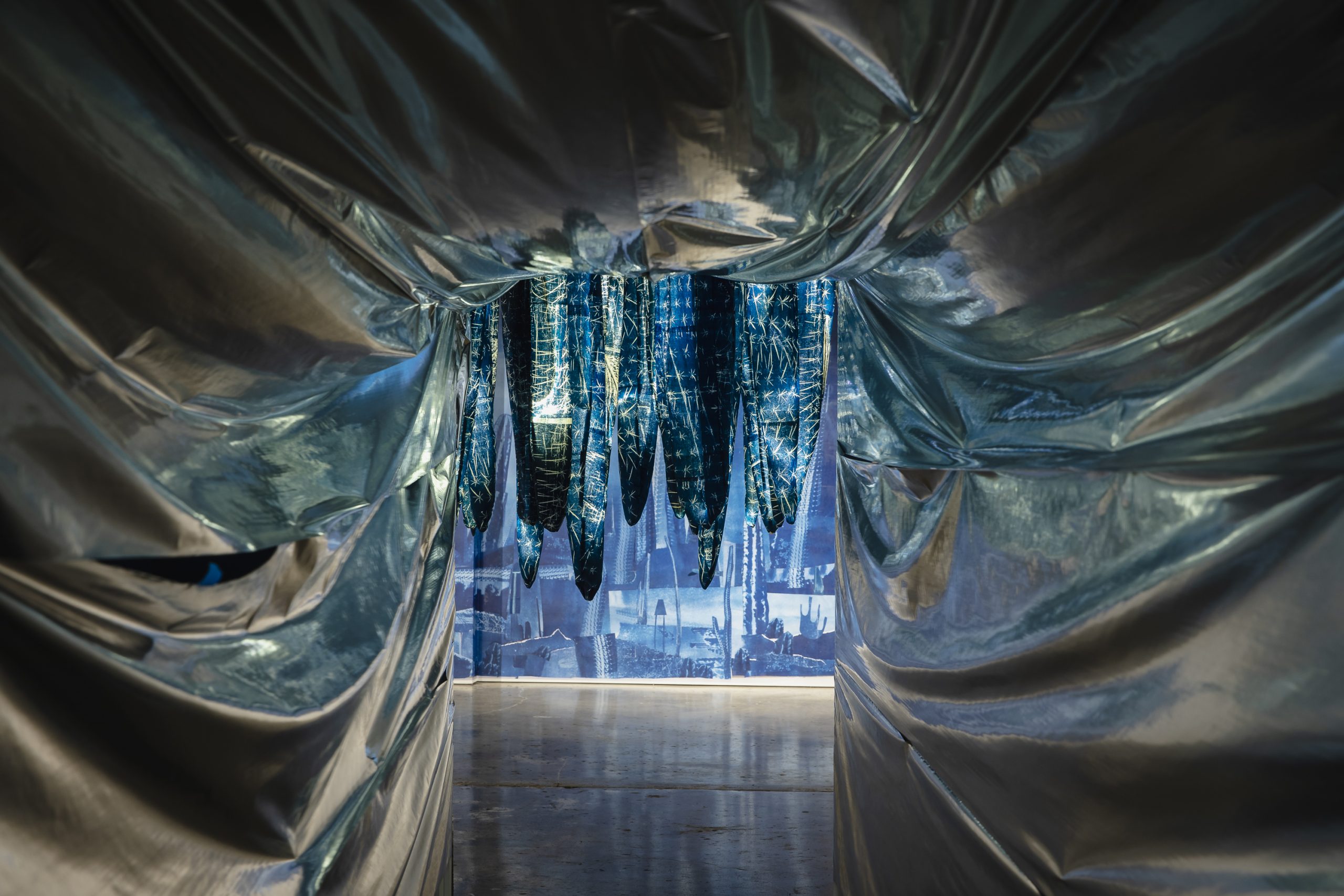

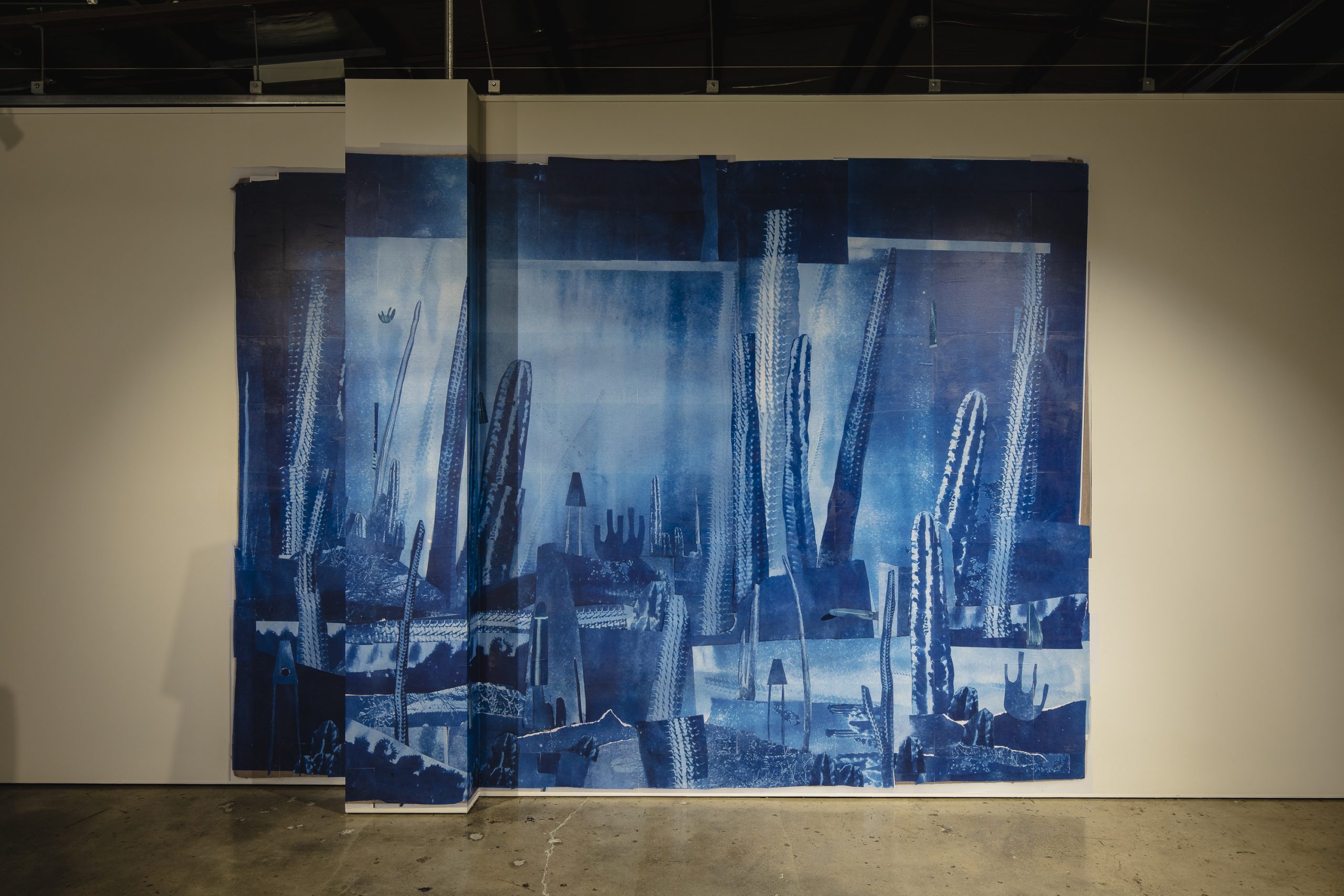

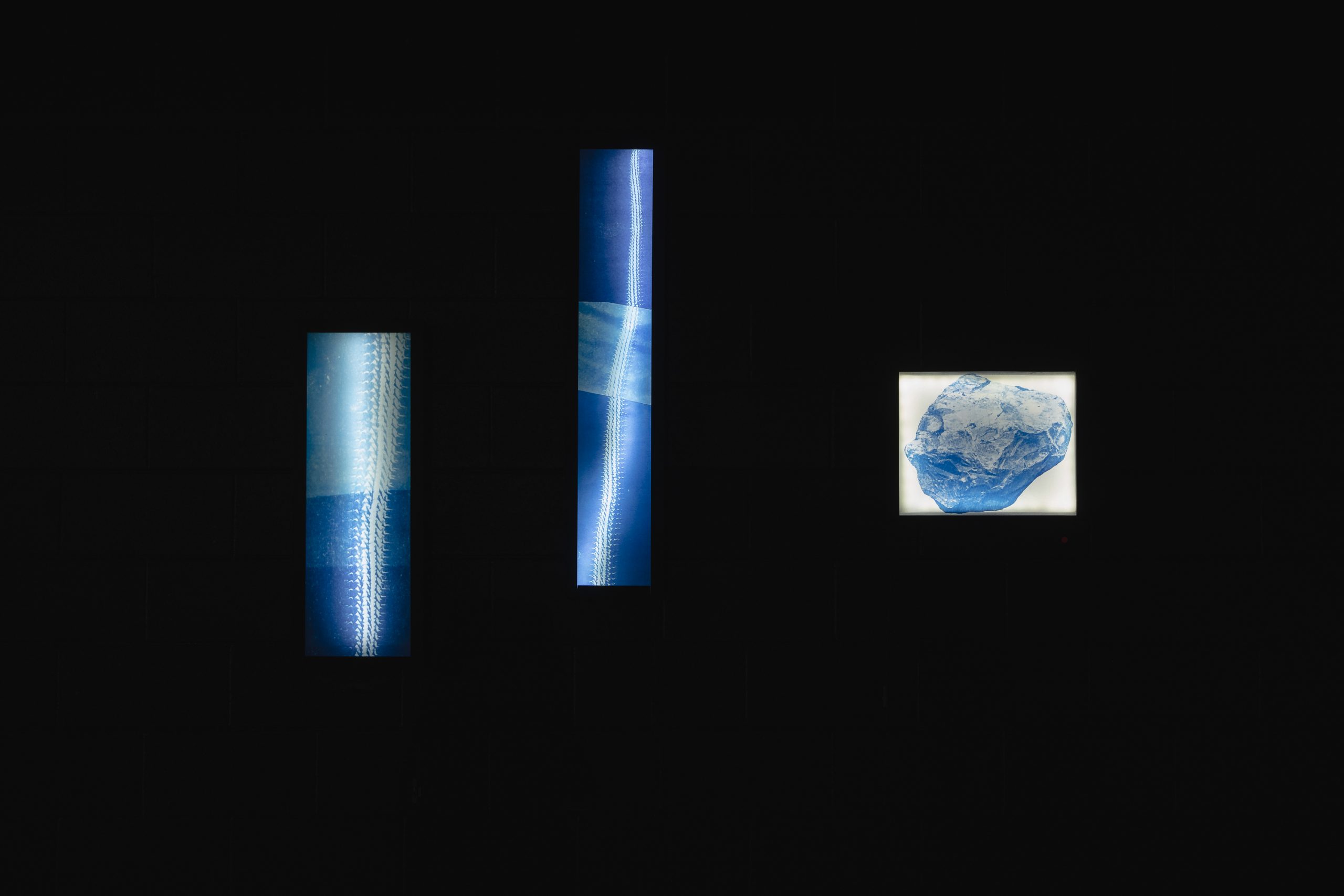

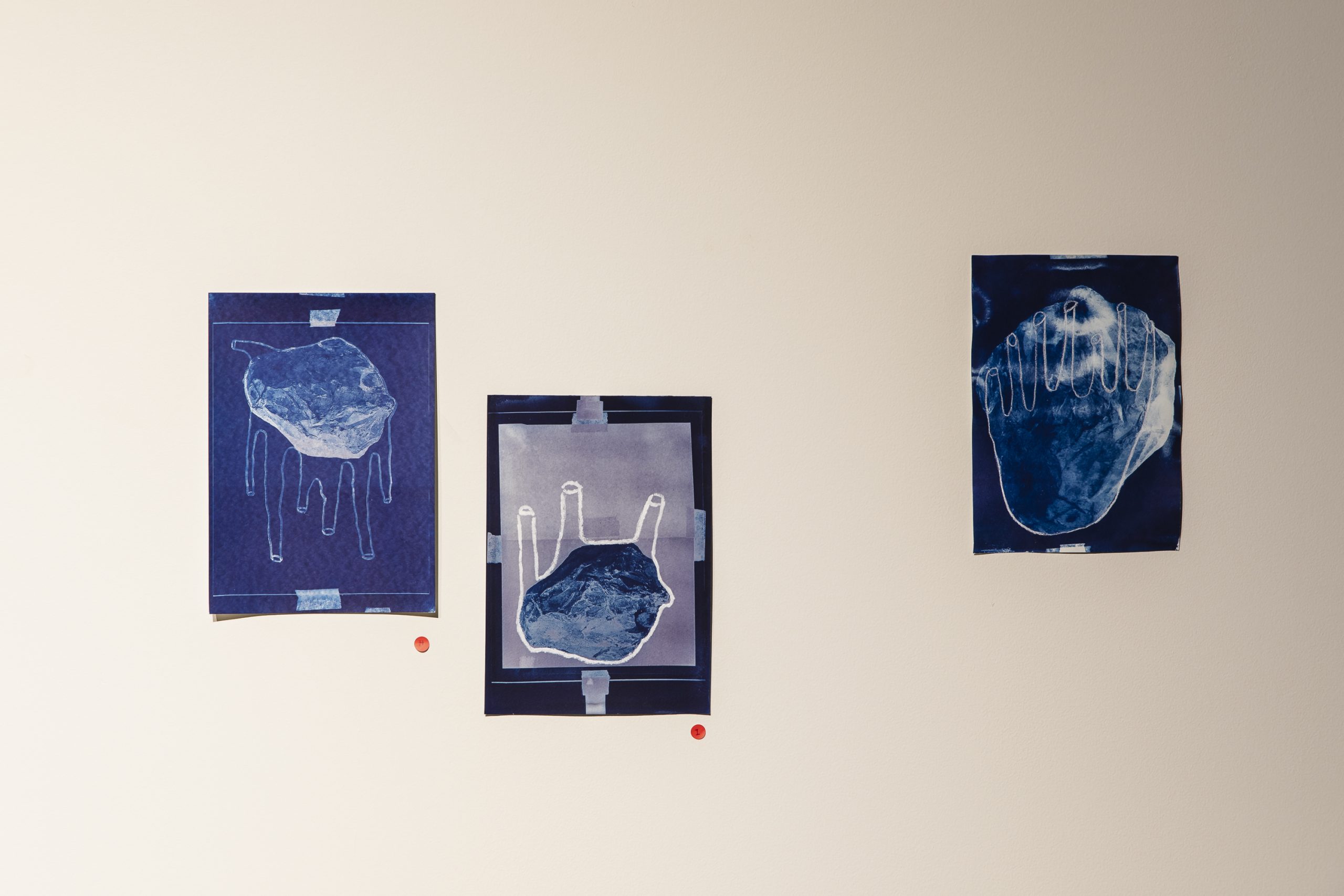
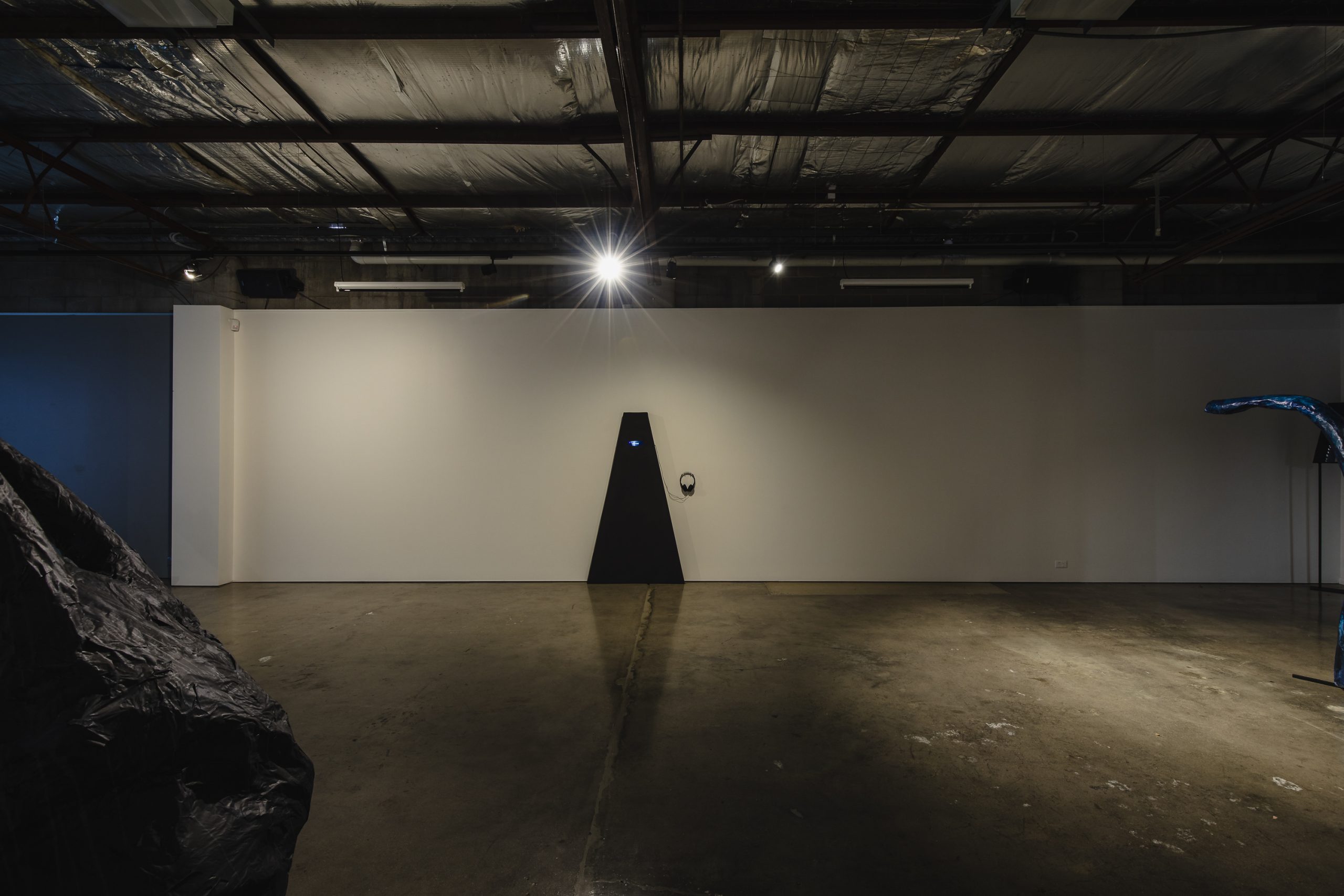
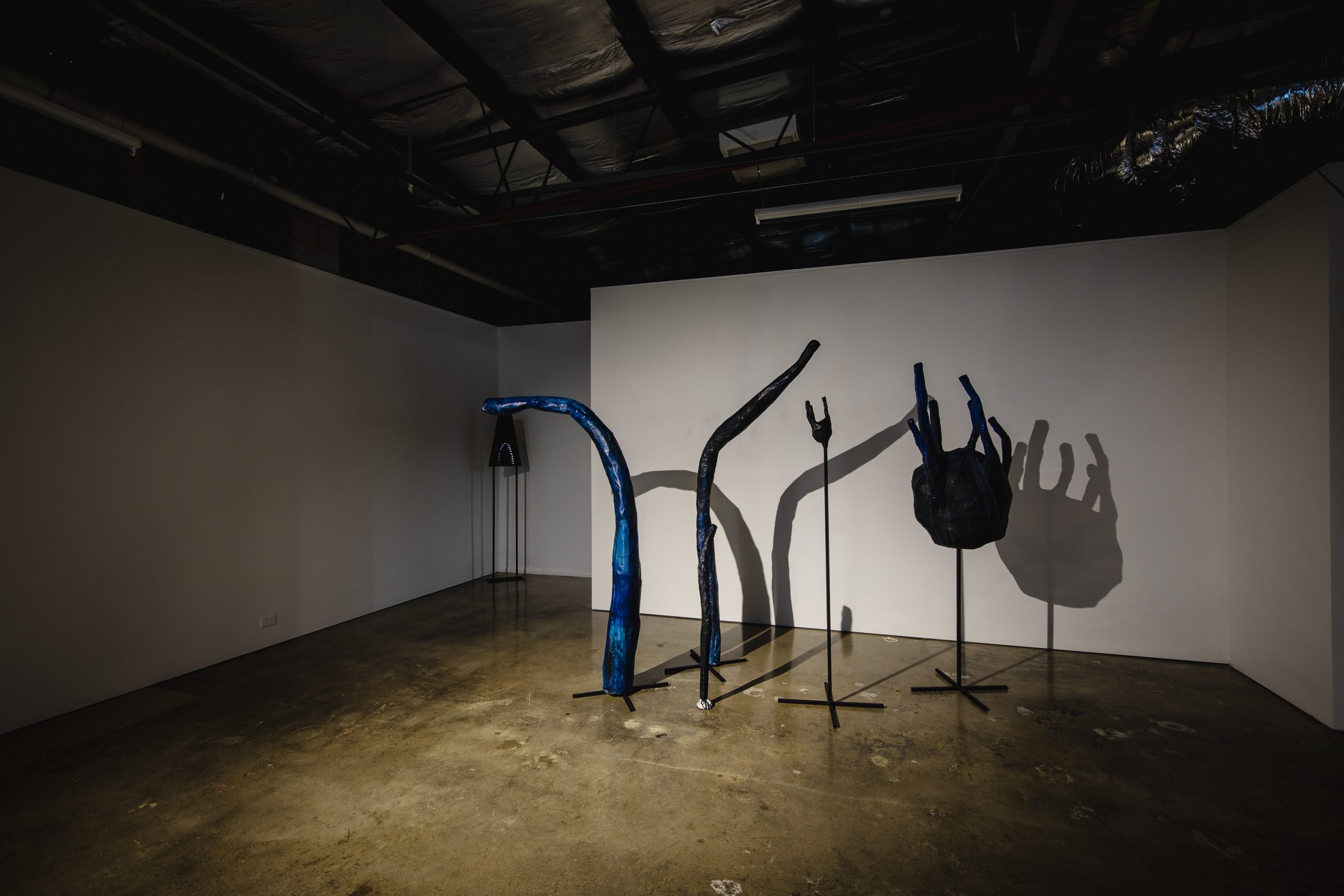
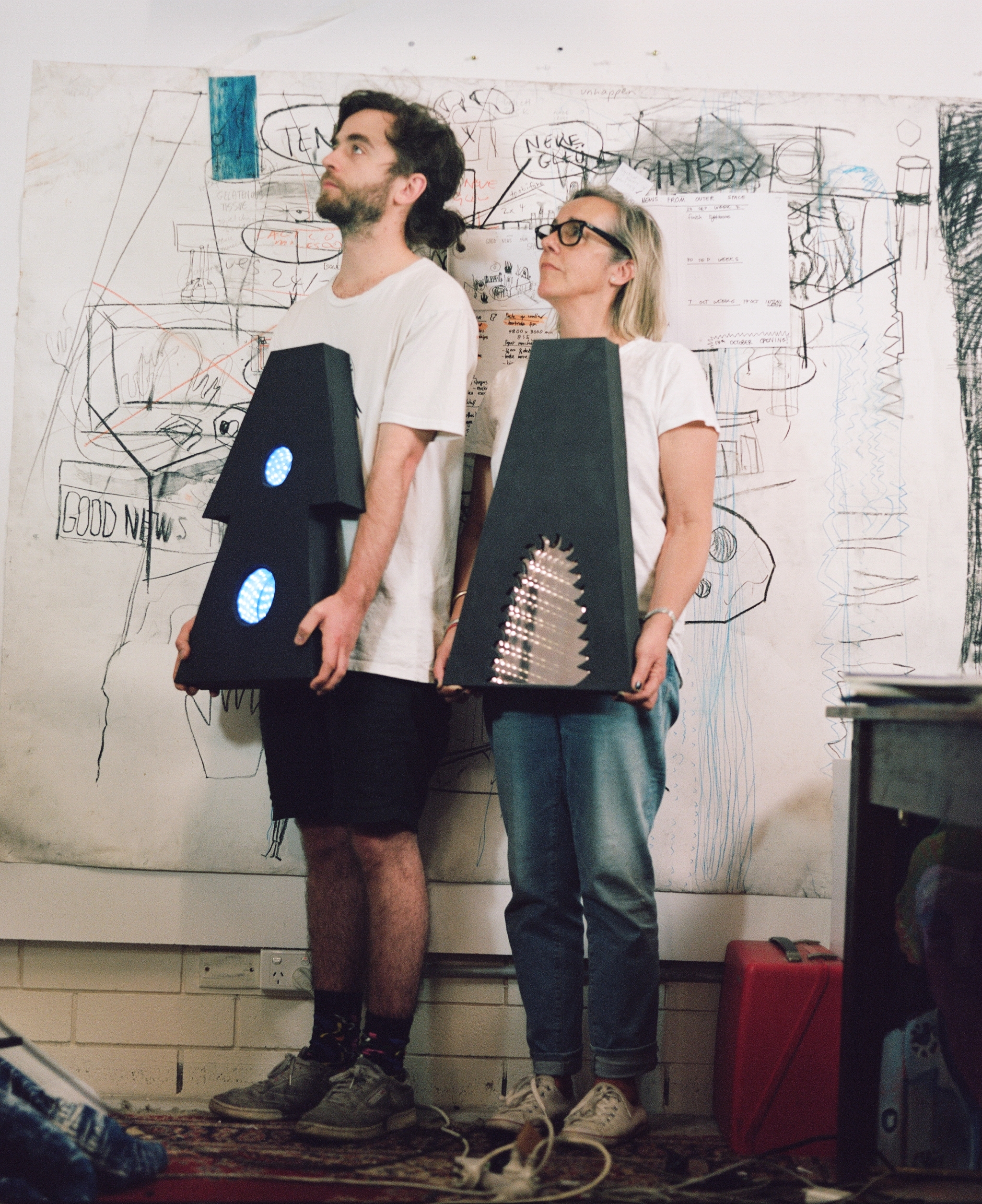
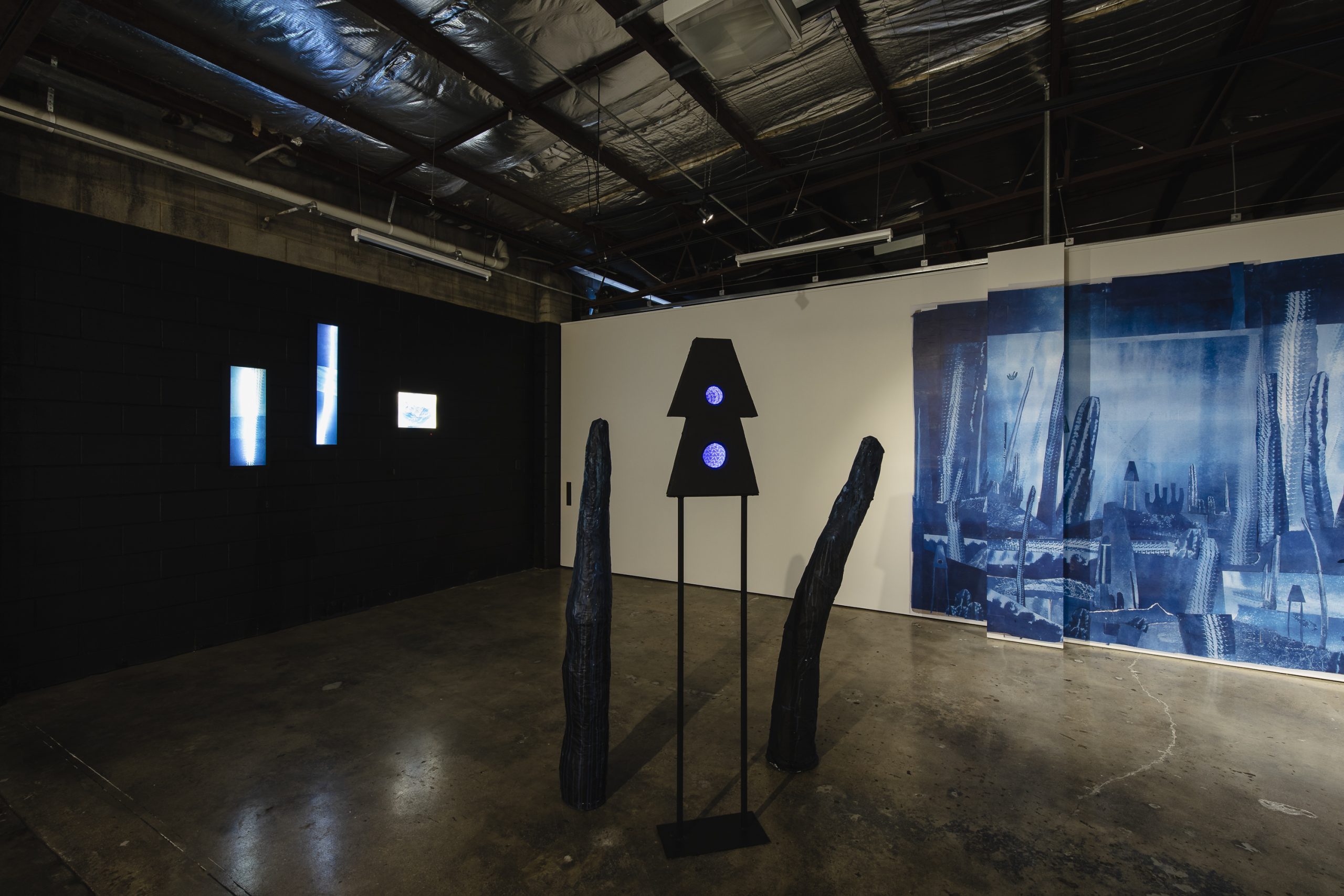

Exhibited at Praxis Artspace
First published in 1989, John Kessel’s science fiction novel Good News From Outer Space is a darkly comic novel that revels in the irrational anxieties at the heart of the quest for knowledge and the truth of reality. In this collaboration between Nicholas Hanisch and Cassie Thring, the absence of certainty and fixed absolutes is countered by humor, curiosity and experiment so that things that don’t work out can be rebuilt, salvaged and turned into something else. As with science fiction, the simultaneous strangeness and familiarity of otherworldly landscapes and unfamiliar experience present an absurd and uncanny paradox, and in the words of Thring, ‘softens the blow’ of the nonsensical absurdities of life and the human condition.
For artists driven by process, the uncertainty of risk and potential fuck up provides an open playing field in which to kick around ideas as they emerge, develop and retreat, take on life as resolved works or are otherwise abandoned altogether. Some ideas take flight and others crash. But this exhibition is not simply about the result or end-product. Over time, Hanisch and Thring have immersed themselves in an ongoing conversation, making work in response to each other, pushing ideas into new corners and stretching things out to see how far they can be taken. A hole is drilled into the wall separating their studio spaces. A rope is pushed through to test something out and pass things back and forth. Materials are ‘cobbled together in a clunky, ad hoc backyard way,’ reminding me of my own childhood experiments and assemblages where chicken coups became spaceship time machines and an old drum and lifejacket morphs into a horse.
Using an almost monochromatic palette of cyanotypes and black paint, the aesthetic of Good News From Outer Space is reminiscent of the Apollo 11 moon landing televised around the globe at a time in which the tropes of science fiction took images and landscapes of our own planet and turned them into something else. Intergalactic robots and space machines were made from old bits of pipe and domestic appliances. For Hanisch and Thring, different materials, objects and spaces become testing grounds for dealing with difficulty, uncertainty and the unknown. In the same way that science fiction expands on and manipulates the existing knowledge of things, Thring and Hanisch take known shapes of giant prickly cacti growing in open, arid earthly space and mutate them into alien forms. Newly invented organic Exo forms are freshly spawned and stretch their searching limbs outward toward the unchartered with slurps and sound machines filling an uneasy space. The conspicuous absence of human figures are replaced by anthropomorphic triangle shapes attached to elongated stilt legs. Mirrors and lights trick the eye into thinking there is an endless depth of receding space in shallow constructed forms.
There is beauty in the strange, and there is a grounding familiarity in the foreign. Good News From Outer Space is an immersive work in which viewers will find and lose themselves at the same time. Enter without helmet and safety gear. Leave with a lighter sense of knowing the dark as a space that is navigated through your own internal bearings and experience.
Essay by Dr. Melanie Cooper
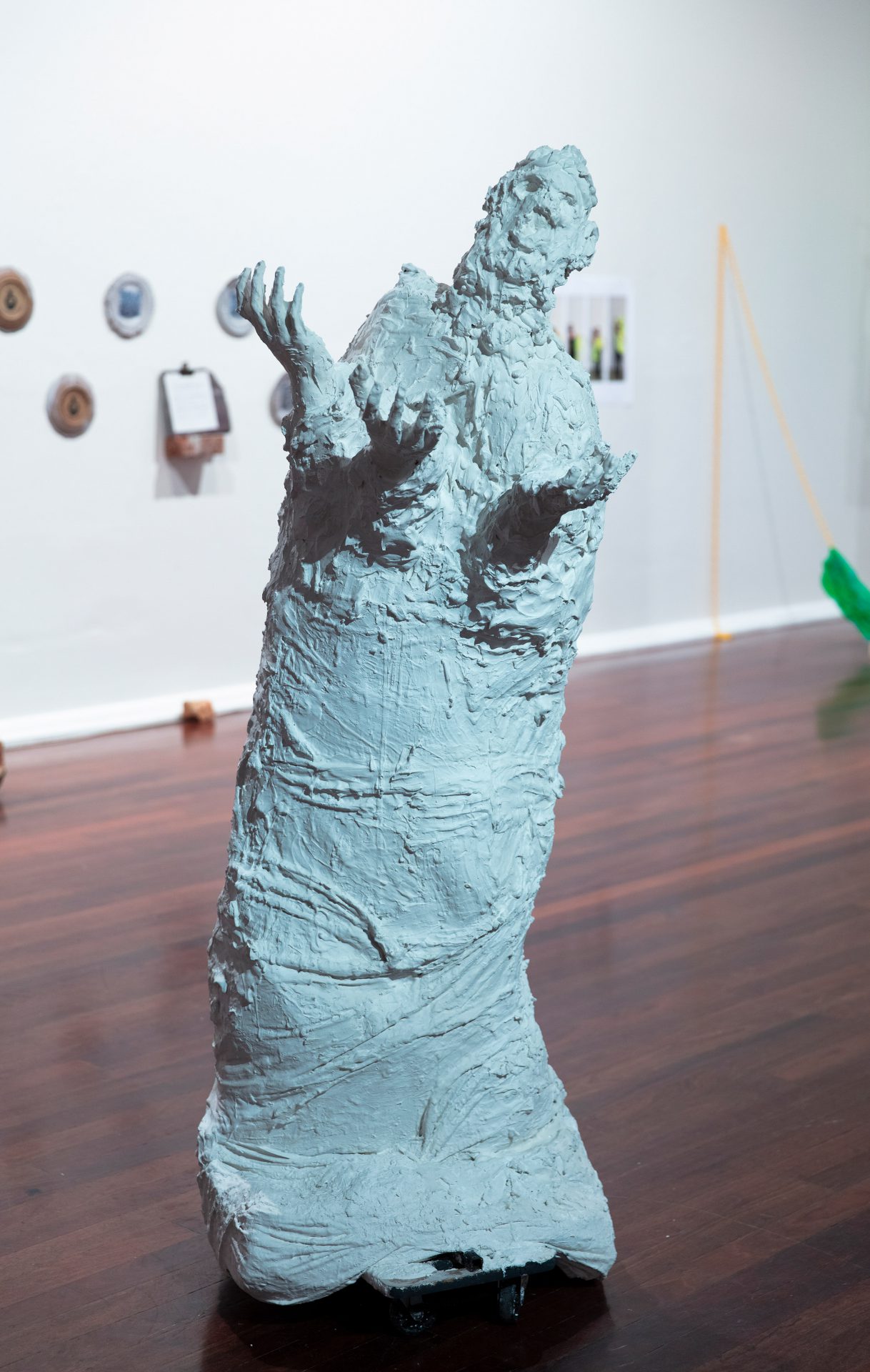
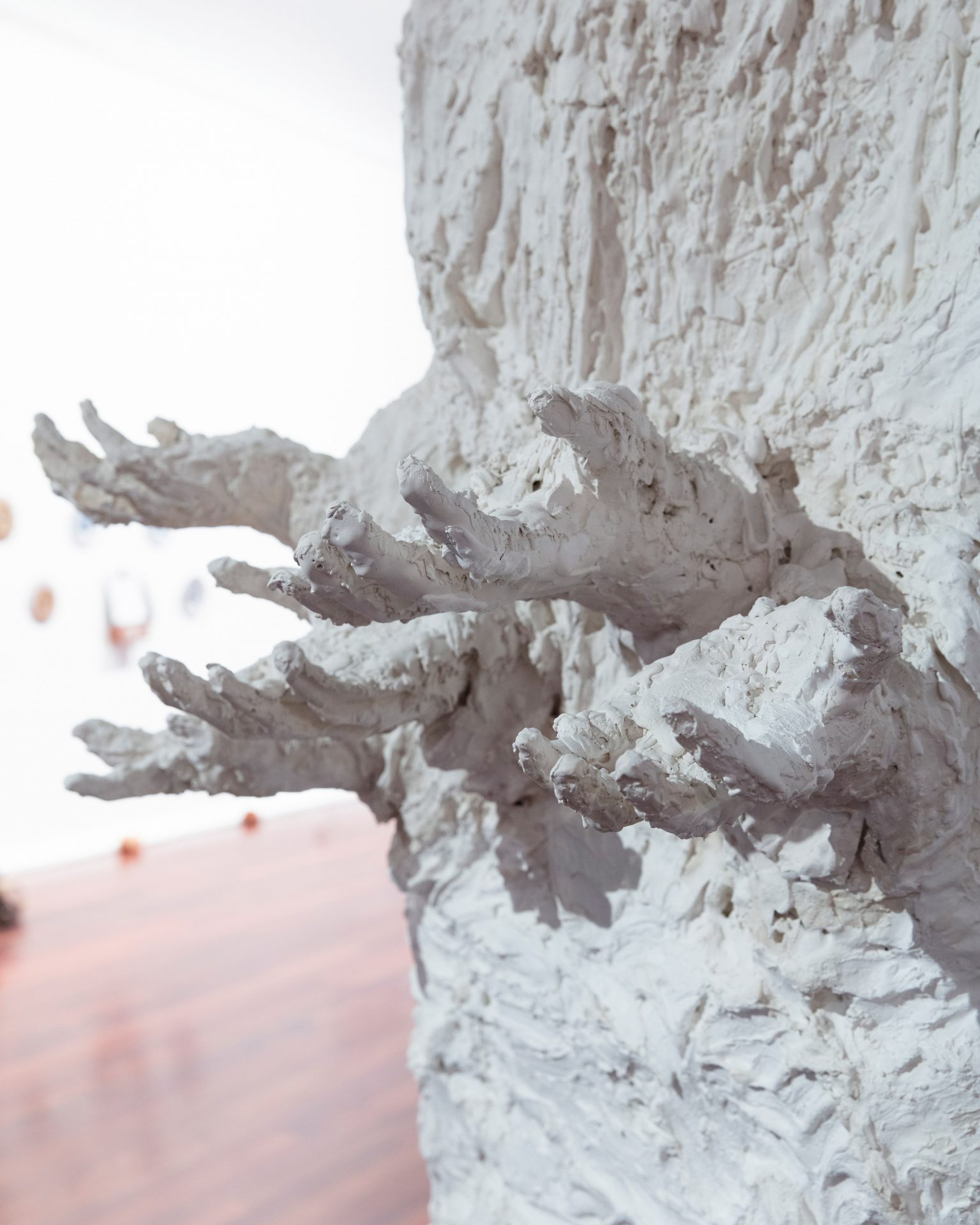
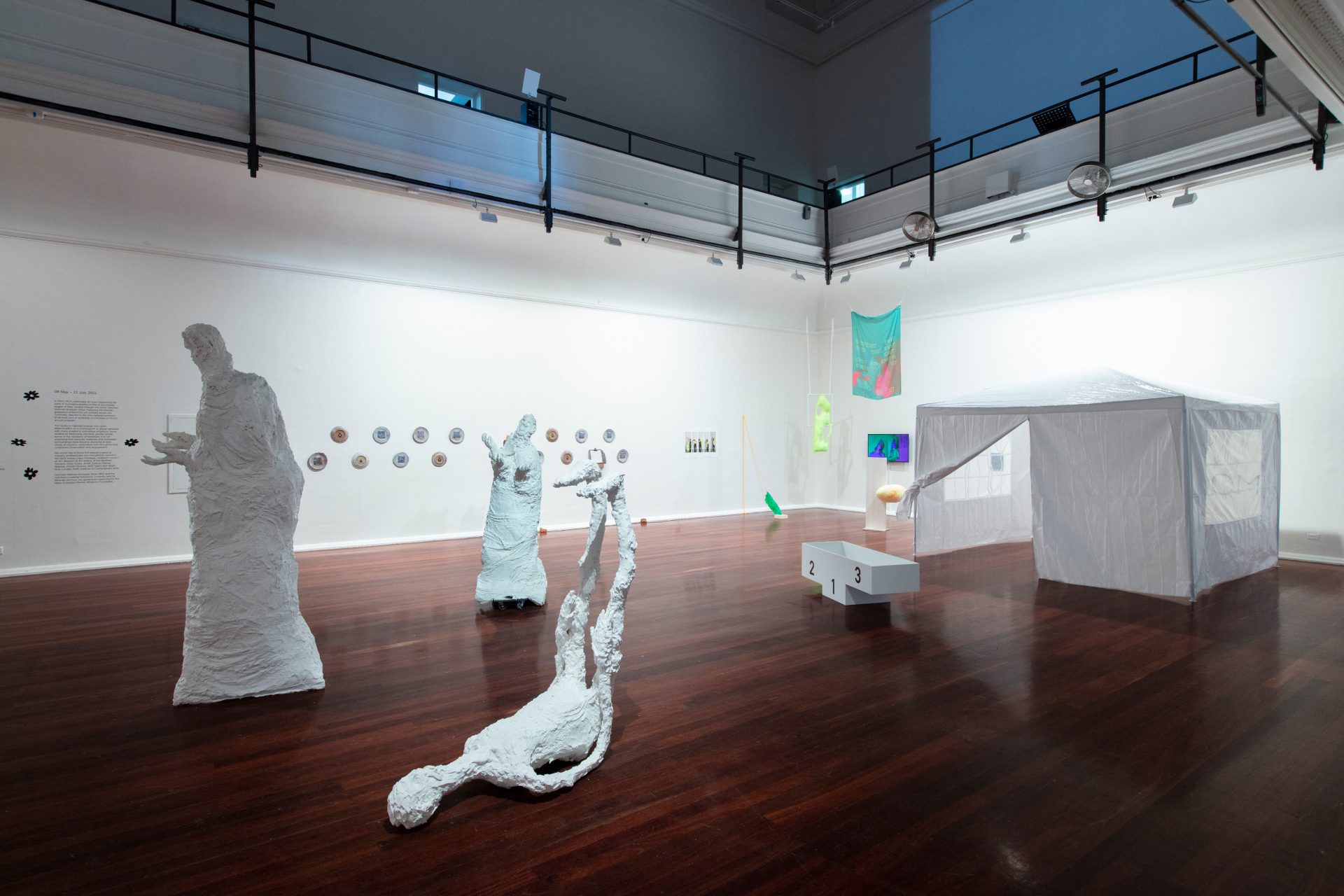
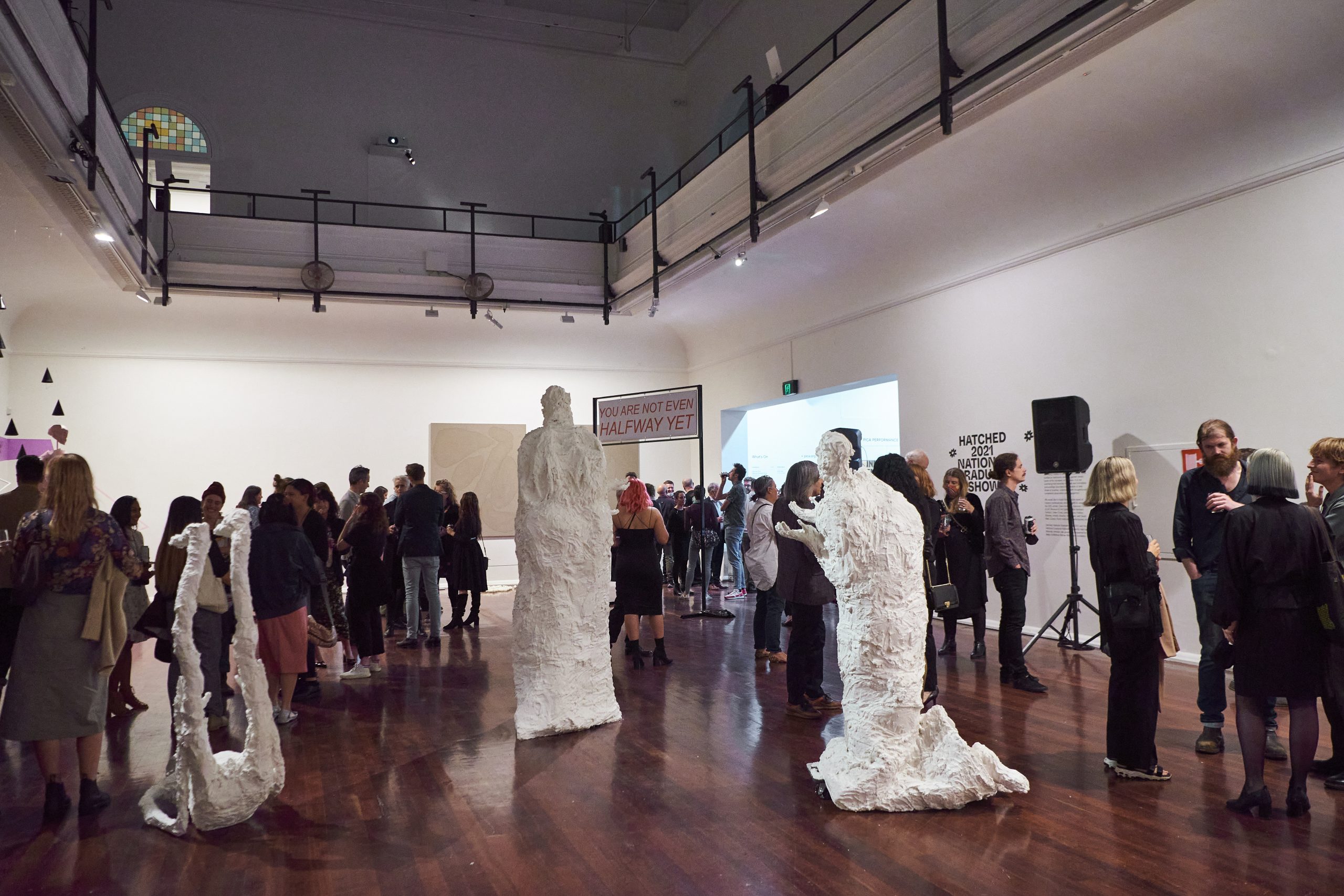
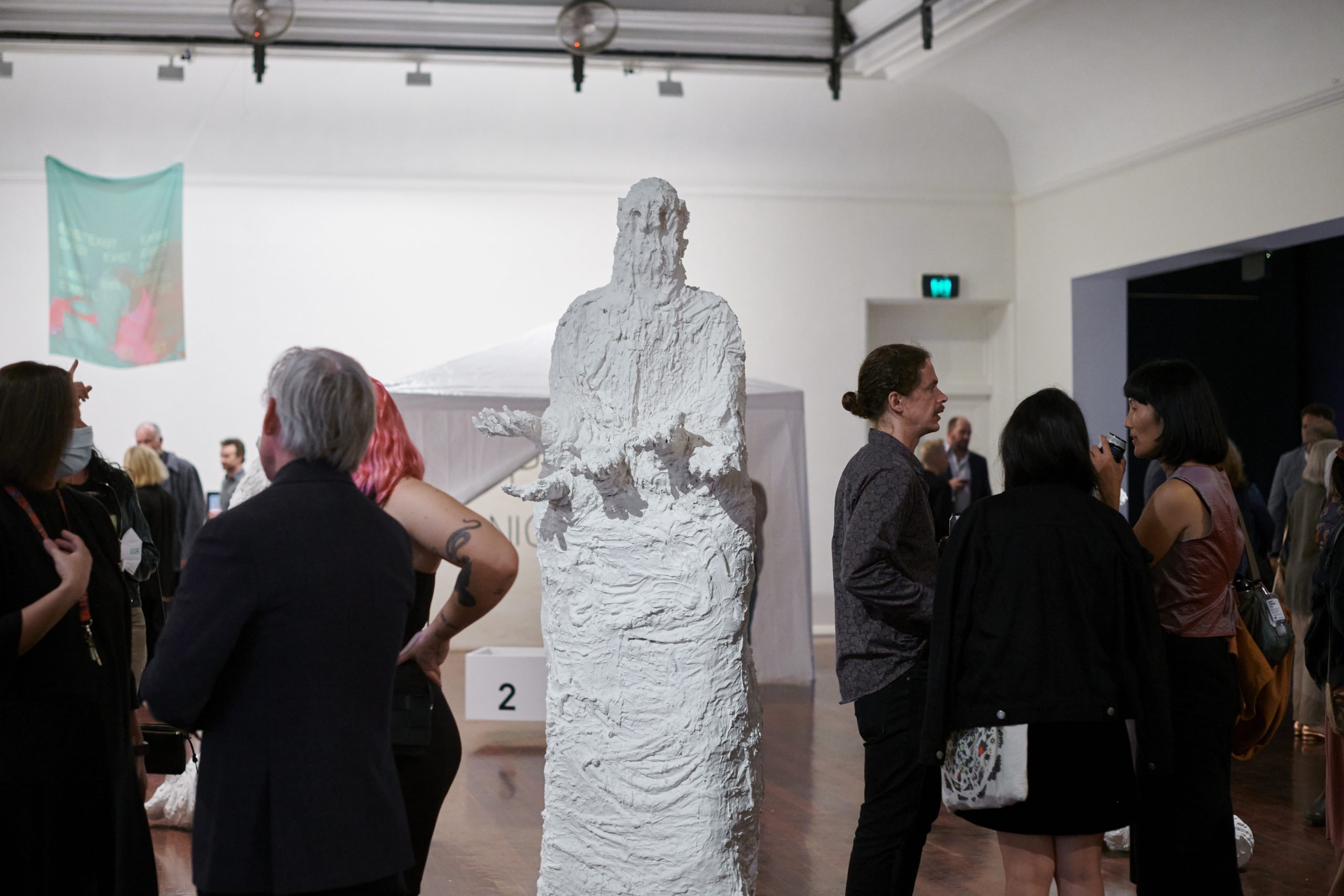
Hatched: National Graduate Show 2021
Perth Institute of Contemporary Arts
In 2021, PICA celebrates 30 years supporting the work of Australia’s leading artists at the earliest stages of their careers through the iconic Hatched: National Graduate Show, the only national exhibition of its kind. Over this time PICA has presented the work of over a thousand artists who have gone on to help define contemporary Australian practice as the leading artists of their generation. This anniversary offers an opportunity to share and understand the impact and importance of the exhibition that forms a cornerstone of PICA’s annual program. Through an exciting program of events, artist talks, digital engagement and professional development opportunities, PICA invites you to reflect and celebrate the value of this beloved exhibition, both in the past and into the future.
From the primordial sludge the being is made: golem, new life, self-replicating cappuccino foam, elemental secrets, body malfunctions, leave a hole for the soul, numinous breath, desiring humanness, pack them away for a rainy day, six drops of sinister sauce, stir vigorously to remove lumps, sneeze into schnoz for desired liveliness, desperately vulnerable, crumbling effigies, it’s alive!
Nicholas Hanisch’s work investigates creation narratives within the history of figurative sculpture, whilst celebrating the humour, the horror, the happenstance, and the sheer endeavour of creation. In his process, he focuses on ways in which to generate effectual responses in the audience, encouraging them to respond to the work as though it were a living being and react through expressions of emotion, whether that be humour, horror, or fear. Hanisch’s series of sculptures specifically focus on the Jewish folktale of the Golem as well as Mary Shelley’s Frankenstein. He uses clay modelling, plaster cast reproduction, and plaster building techniques to form larger-than-life sculptures that encourage imaginative responses from the viewer. During the making process, these sculptures constantly evolved, responded to, and adapted to their surroundings. Like Prometheus moulding man in Greek mythology or the cadaver amalgamation of Frankenstein’s Monster, Hanisch imbues his sculptures with a sense of life that aims to generate a human response with the viewer.
Photography by Bo Wong.
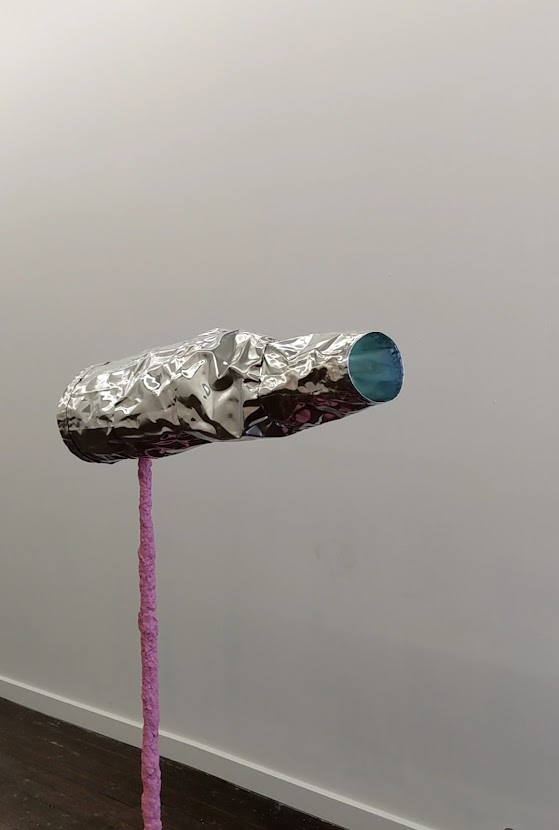
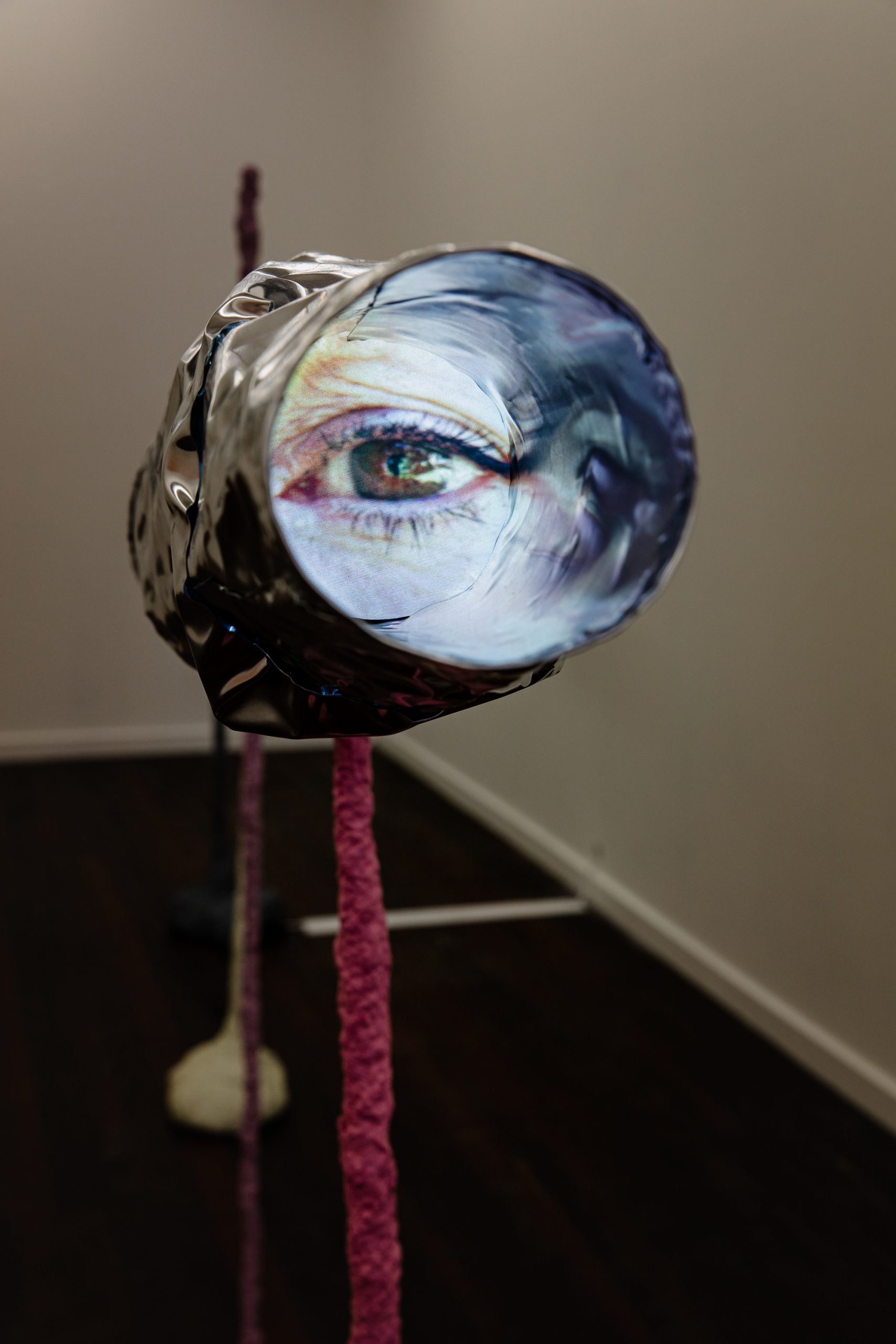
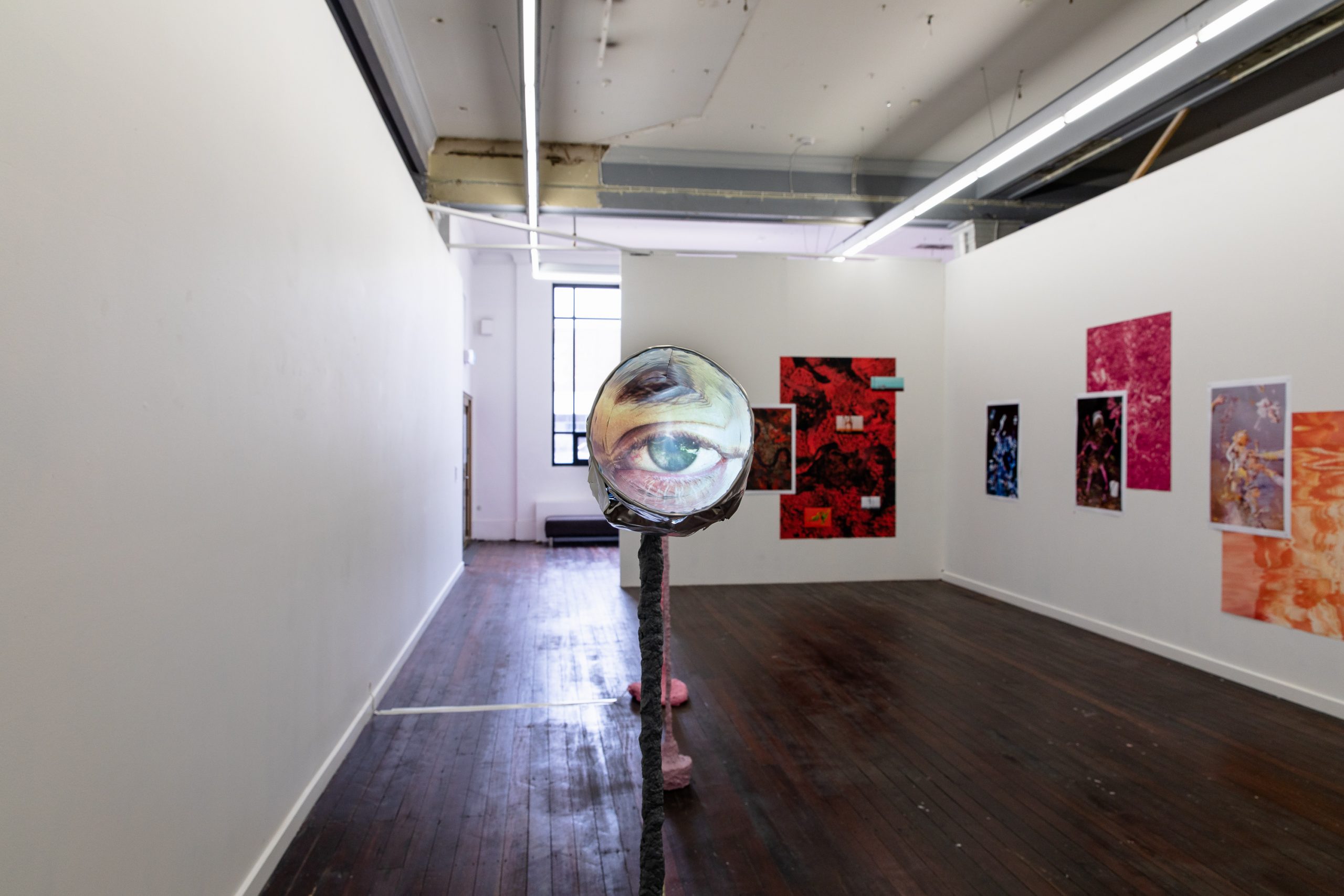
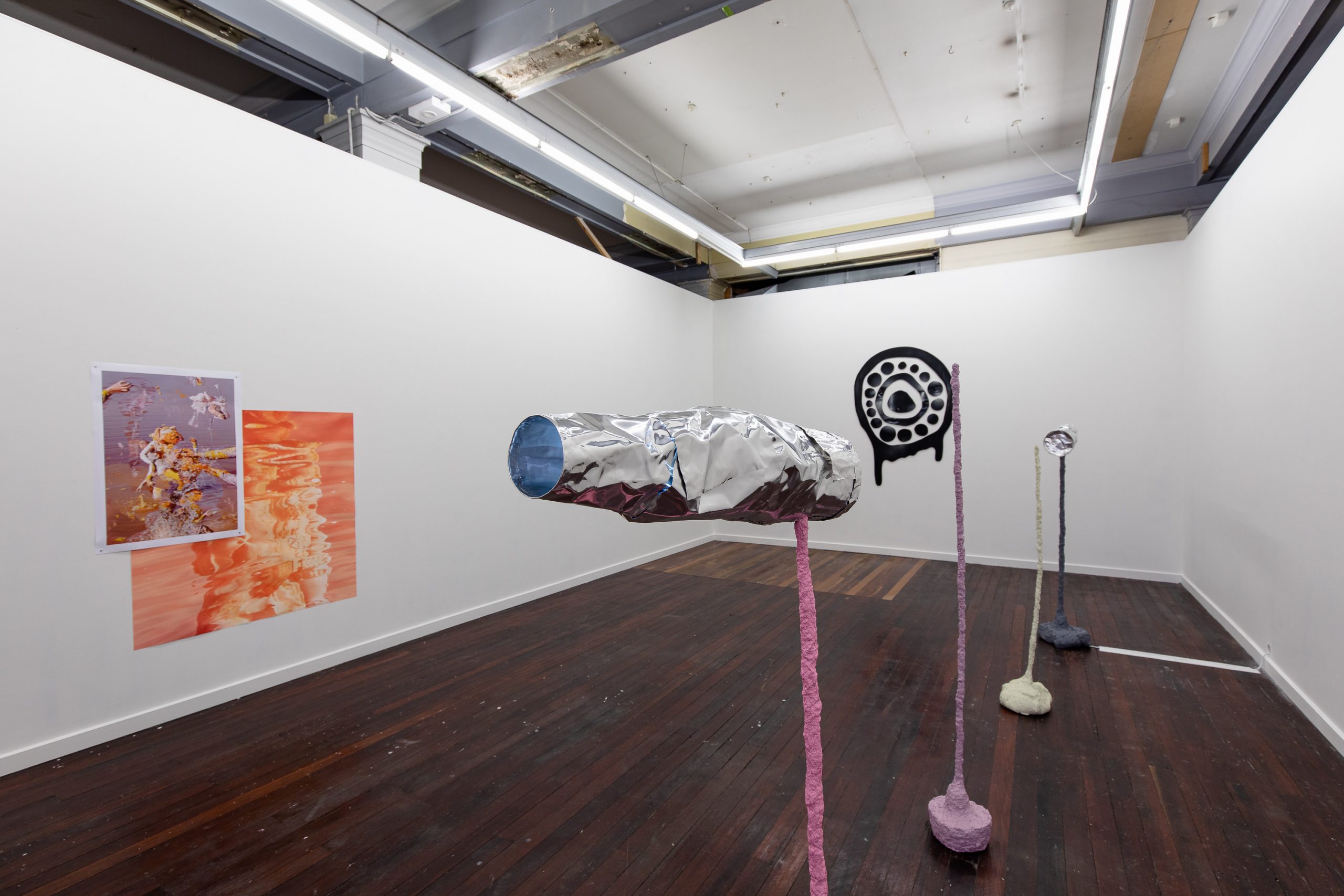
Adelaide X features five collaborative duos based in Greater Adelaide, on Kaurna Country. There is currently a global shift towards collaborative practices in contemporary art, and this is reflected in the number of recent collaborations between South Australian artists. These alliances not only show courageous experimentation but enhance networks and create dynamic exchanges between artists. Adelaide X examines the nature of collaboration in the local context and investigates the distinct attributes within the South Australian arts ecology that foster such unions.
All the participating artists have received recognition for their practice as solo artists. In collaborating, their powers combine and their voices are amplified. These partnerships have been instigated by the artists out of mutual respect and shared artistic interests. These alliances invite exploration and play as the artists push each other into new realms, resulting in ground breaking artistic projects that reflect on the collective concerns of our region and what it means to work together.
Every Idea We’re Going to Have, 2021, Nicholas Hansich & Cassie Thring. Photography by Rosina Possingham.
Nicholas Hanisch and Cassie Thring are self-described optimists. For Adelaide X they have given physical form to their collaborative process. In doing so they have made the intangible flow of ideas between them, tangible. The installation functions as a giant synapse firing directly between them. We are offered the opportunity to see inside this duos collective mind, but only to discover the object stares back. We are as much the observed and the voyeur. The two share a studio space and are in constant dialogue, to the point where it is now speculated that they communicate with each other telepathically.
Adelaide X curated by Suzanne Close
ft.
Sasha Grbich x Kelly Reynolds
Thomas Readett x Elizabeth Yanyi Close
Cassie Thring x Nicholas Hanisch
Rosina Possingham x Brianna Speight
Inneke Taal x Nicole Clift as tandem projects